Ray Fraley's Photo Gallery
Insects
Dragonflies
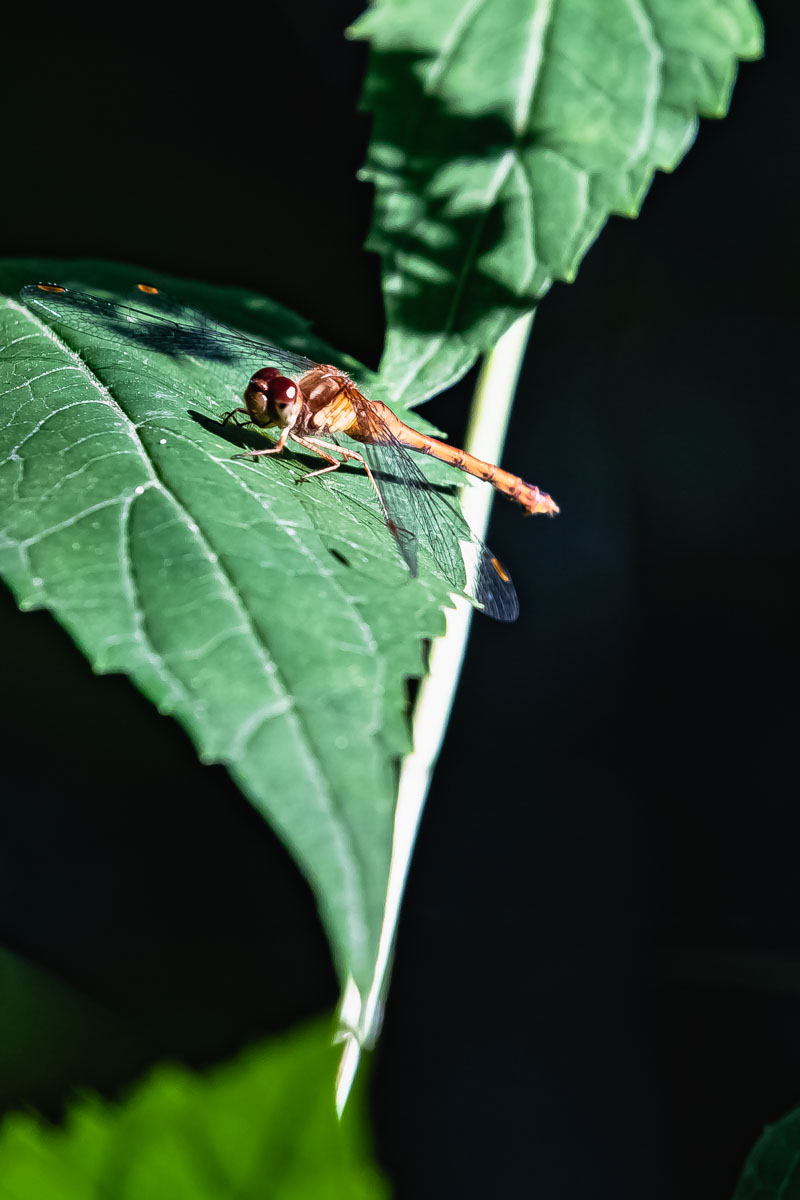
Autumn Meadowhawk
(Sympetrum vicinum)
| D79A4948 | 1962x2943 |
| Image Details | Field Reference Details |
| Camera | Canon EOS 5D Mk IV |
| Lens | EF70-200mm f/2.8L IS II USM |
| ISO | 200 |
| Aperture | f/8.0 |
| Shutter | 1/125 |
| Wings | Transparent with no bold banding; subtle amber tint near the base. |
| Body | Reddish-brown with black striping along the thorax and abdomen |
| Eyes | Chestnut with a slight bronze sheen, slightly separated. |
| Range | Northern U.S. and Southern Canada |
| Habitat | Shallow, permanent ponds, lakes, marshes, bogs, and slow-moving streams near wooded areas. |
| Perching | Resting horizontally on grass stems, twigs, or leafs far from water. They have a hover-perch-hover rhythm. |
| Flight Style | Quick and agile, they can fly in quick bursts; versatile flight includes straight up and down. |
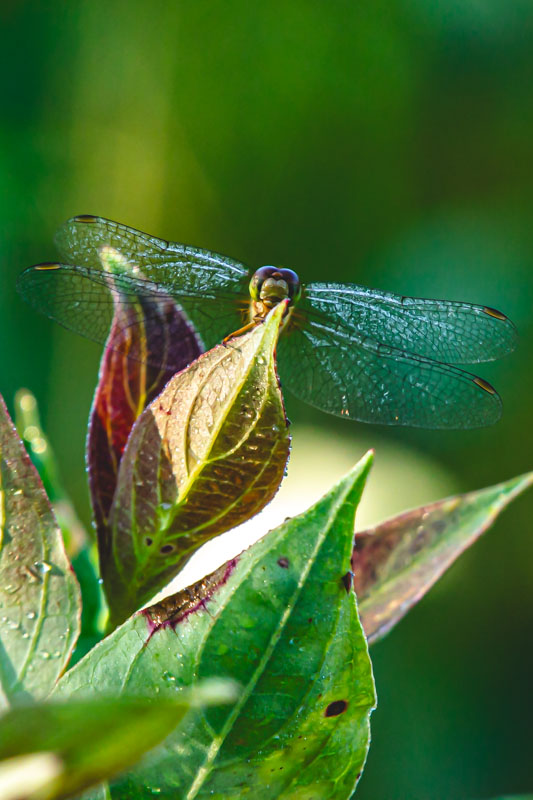
Autumn Meadowhawk
(Sympetrum vicinum)
| _21A2195 | 2637x3955 |
| Image Details | Field Reference Details |
| Camera | Canon EOS 5D Mk IV |
| Lens | EF70-200mm f/2.8L IS II USM |
| ISO | 2500 |
| Aperture | f/13.0 |
| Shutter | 1/125 |
| Wings | Transparent with no bold banding; subtle amber tint near the base. |
| Body | Reddish-brown with black striping along the thorax and abdomen |
| Eyes | Dark reddish-brown, slightly separated. |
| Range | Northern U.S. and Southern Canada |
| Habitat | Shallow, permanent ponds, lakes, marshes, bogs, and slow-moving streams near wooded areas. |
| Perching | Resting horizontally on grass stems, twigs, or leafs far from water. They have a hover-perch-hover rhythm. |
| Flight Style | Quick and agile, they can fly in quick bursts; versatile flight includes straight up and down. |
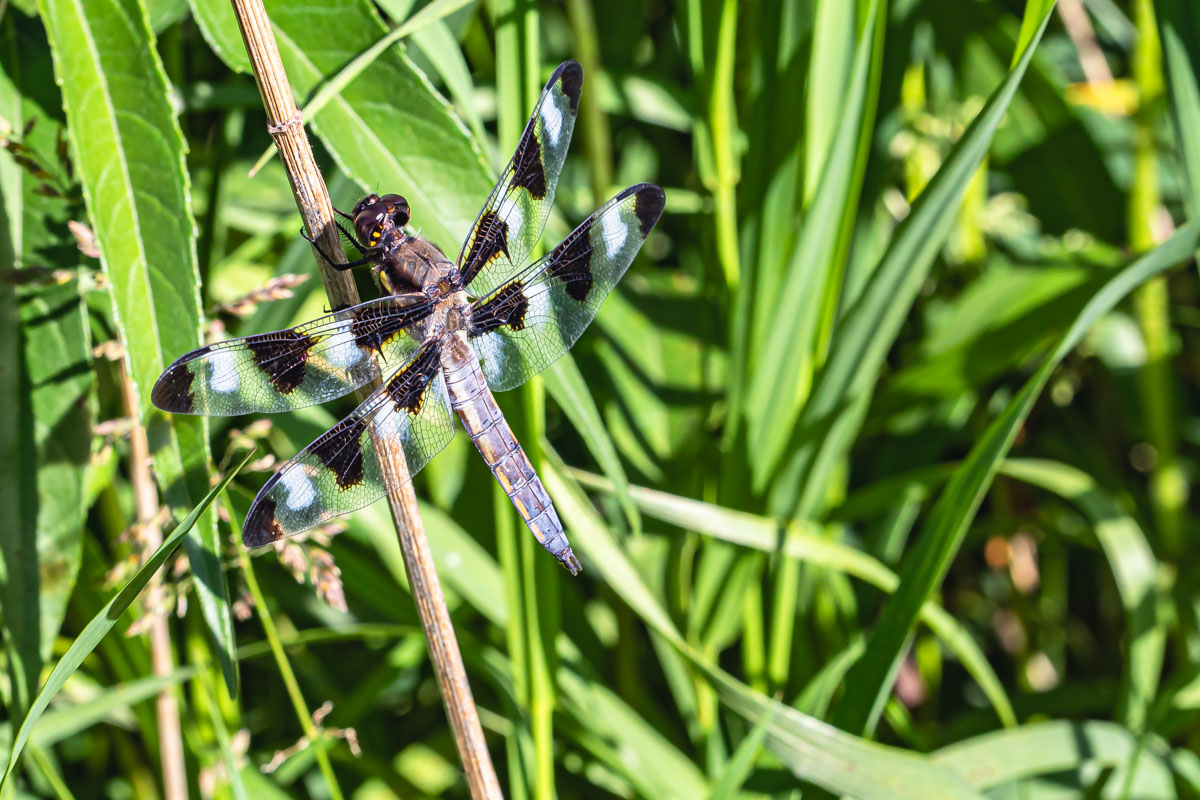
Twelve-spotted Skimmer
(Libellula pulchella)
| D79A3834 | 1742x2613 |
| Image Details | Field Reference Details |
| Camera | Canon EOS 5D Mk IV |
| Lens | EF100mm f/2.8 Macro USM |
| ISO | 200 |
| Aperture | f/10.0 |
| Shutter | 1/200 |
| Wings | Three dark spots per wing (12 total); clear or slightly smoky tips. |
| Body | Powder blue abdomen with dark markings |
| Eyes | Dark brown to black |
| Range | Most of North America |
| Habitat | Large bodies of water, still or slow moving ponds. |
| Perching | Branches or reeds near water's edge. |
| Flight Style | Stong, direct, often patrols open water. |
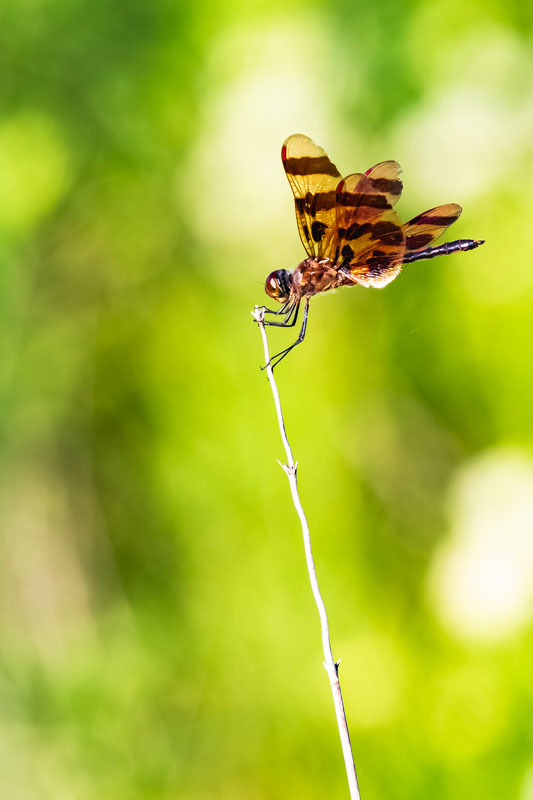
Halloween Pennant
(Celithemis eponina)
| E21A2117 | 2201x3302 |
| Image Details | Field Reference Details |
| Camera | Canon EOS 5D Mk IV |
| Lens | EF70-200mm f/2.8L IS II USM (2x) |
| ISO | 800 |
| Aperture | f/13.0 |
| Shutter | 1/320 |
| Wings | Transparent with orange-yellow and dark brown bands; often a reddish tint at tips. |
| Body | Slender, typically orange or yellow with dark striping. |
| Eyes | Large, reddish-brown or amber. |
| Range | Eastern and Central U.S. |
| Habitat | Ponds, marshes, slow-moving streams, grassy fields near water. |
| Perching | Likes swaying tall grasses or twigs; often perches in open sunlight. |
| Flight Style | Fluttery, slow |
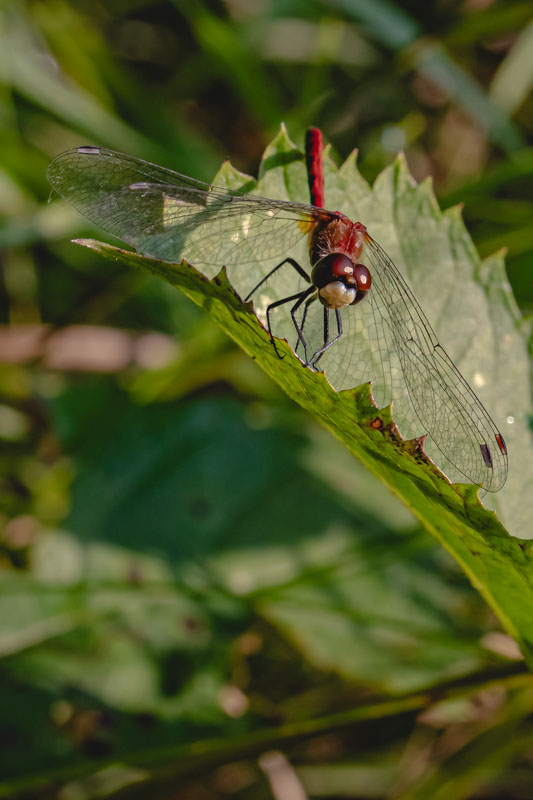
White-faced Meadowhawk
(Sympetrum obtrusum)
| D79A0217 | 1854x2781 |
| Image Details | Field Reference Details |
| Camera | Canon EOS 5D Mk IV |
| Lens | EF100mm f/2.8L Macro IS USM |
| ISO | 500 |
| Aperture | f/13.0 |
| Shutter | 1/200 |
| Wings | Transparent with no bold banding; subtle amber tint near the base. |
| Body | Red with black striping along the thorax and abdomen. |
| Eyes | Dark reddish-brown, slightly separated. |
| Range | Northern U.S. and Southern Canada. |
| Habitat | Shallow, permanent ponds, lakes, marshes, bogs, and slow-moving streams near wooded areas. |
| Perching | Rests horizontally on grass stems, twigs, or leaves far from water. Exhibits a hover–perch–hover rhythm. |
| Flight Style | Quick and agile; capable of burst flights and vertical movement. |
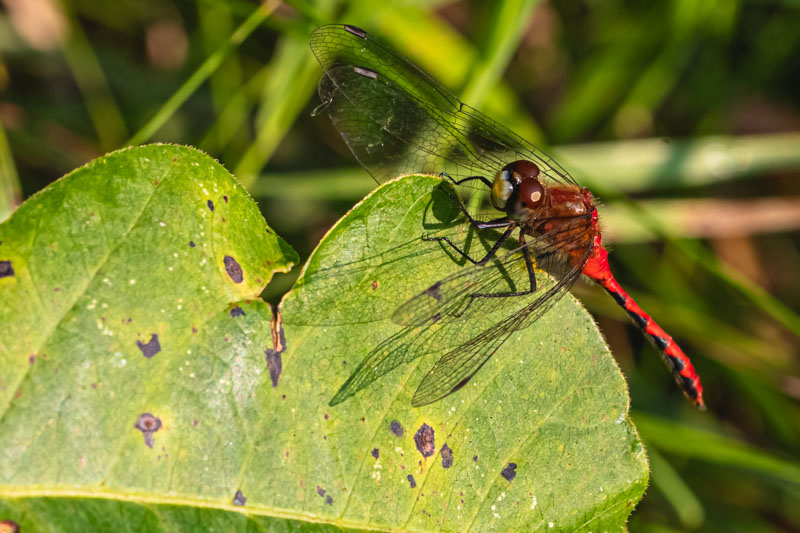
White-faced Meadowhawk
(Sympetrum obtrusum)
| D79A0209 | 4606x3071 |
| Image Details | Field Reference Details |
| Camera | Canon EOS 5D Mk IV |
| Lens | EF100mm f/2.8L Macro IS USM |
| ISO | 800 |
| Aperture | f/13.0 |
| Shutter | 1/200 |
| Wings | Transparent with no bold banding; subtle amber tint near the base. |
| Body | Red with black striping along the thorax and abdomen. |
| Eyes | Dark reddish-brown, slightly separated. |
| Range | Northern U.S. and Southern Canada. |
| Habitat | Shallow, permanent ponds, lakes, marshes, bogs, and slow-moving streams near wooded areas. |
| Perching | Rests horizontally on grass stems, twigs, or leaves far from water. Exhibits a hover–perch–hover rhythm. |
| Flight Style | Quick and agile; capable of burst flights and vertical movement. |
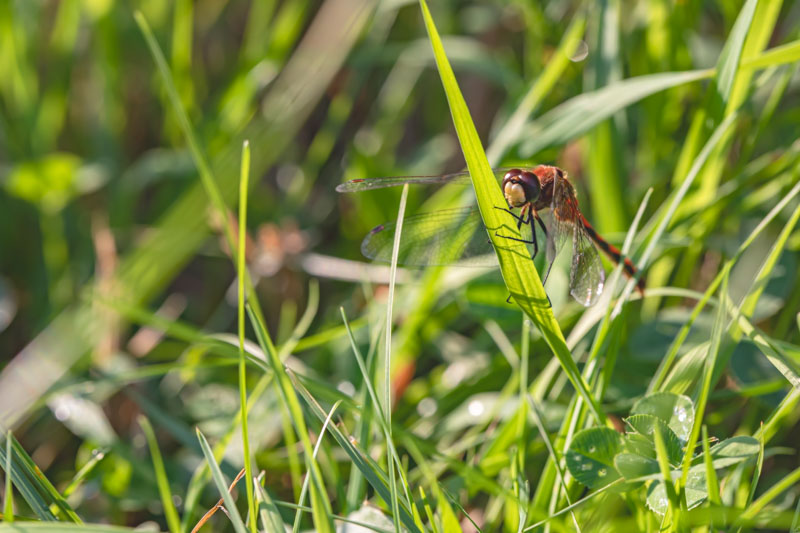
White-faced Meadowhawk
(Sympetrum obtrusum)
| D79A0443 | 4606x3071 |
| Image Details | Field Reference Details |
| Camera | Canon EOS 5D Mk IV |
| Lens | EF100mm f/2.8L Macro IS USM |
| ISO | 200 |
| Aperture | f/8.0 |
| Shutter | 1/125 |
| Wings | Transparent with no bold banding; subtle amber tint near the base. |
| Body | Red with black striping along the thorax and abdomen. |
| Eyes | Dark reddish-brown, slightly separated. |
| Range | Northern U.S. and Southern Canada. |
| Habitat | Shallow, permanent ponds, lakes, marshes, bogs, and slow-moving streams near wooded areas. |
| Perching | Rests horizontally on grass stems, twigs, or leaves far from water. Exhibits a hover–perch–hover rhythm. |
| Flight Style | Quick and agile; capable of burst flights and vertical movement. |
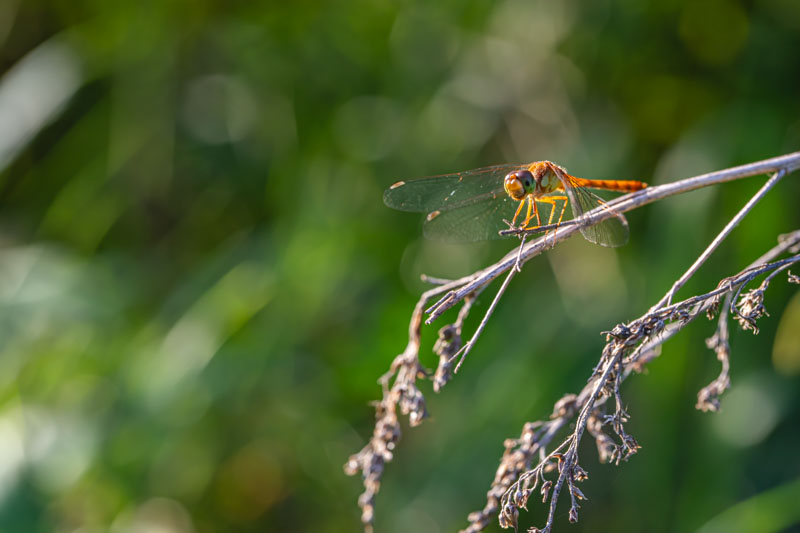
White-faced Meadowhawk
(Sympetrum obtrusum)
| D79A0448 | 6720x4480 |
| Image Details | Field Reference Details |
| Camera | Canon EOS 5D Mk IV |
| Lens | EF100mm f/2.8L Macro IS USM |
| ISO | 200 |
| Aperture | f/8.0 |
| Shutter | 1/125 |
| Wings | Transparent with no bold banding; subtle amber tint near the base. |
| Body | Red with black striping along the thorax and abdomen. |
| Eyes | Dark reddish-brown, slightly separated. |
| Range | Northern U.S. and Southern Canada. |
| Habitat | Shallow, permanent ponds, lakes, marshes, bogs, and slow-moving streams near wooded areas. |
| Perching | Rests horizontally on grass stems, twigs, or leaves far from water. Exhibits a hover–perch–hover rhythm. |
| Flight Style | Quick and agile; capable of burst flights and vertical movement. |

Autumn Meadowhawk
(Sympetrum vicinum)
| _21A1763 | 3091x2061 |
| Image Details | Field Reference Details |
| Camera | Canon EOS 5D Mk IV |
| Lens | EF70-200mm f/2.8L IS II USM |
| ISO | 200 |
| Aperture | f/11.0 |
| Shutter | 1/80 |
| Wings | Transparent with no bold banding; subtle amber tint near the base. |
| Body | Reddish-brown with black striping along the thorax and abdomen |
| Eyes | Dark reddish-brown, slightly separated. |
| Range | Northern U.S. and Southern Canada |
| Habitat | Shallow, permanent ponds, lakes, marshes, bogs, and slow-moving streams near wooded areas. |
| Perching | Resting horizontally on grass stems, twigs, or leafs far from water. They have a hover-perch-hover rhythm. |
| Flight Style | Quick and agile, they can fly in quick bursts; versatile flight includes straight up and down. |

Autumn Meadowhawk
(Sympetrum vicinum)
| _21A2185 | 4898x3265 |
| Image Details | Field Reference Details |
| Camera | Canon EOS 5D Mk IV |
| Lens | EF70-200mm f/2.8L IS II USM |
| ISO | 1600 |
| Aperture | f/13.0 |
| Shutter | 1/125 |
| Wings | Transparent with no bold banding; subtle amber tint near the base. |
| Body | Reddish-brown with black striping along the thorax and abdomen |
| Eyes | Dark reddish-brown, slightly separated. |
| Range | Northern U.S. and Southern Canada |
| Habitat | Shallow, permanent ponds, lakes, marshes, bogs, and slow-moving streams near wooded areas. |
| Perching | Resting horizontally on grass stems, twigs, or leafs far from water. They have a hover-perch-hover rhythm. |
| Flight Style | Quick and agile, they can fly in quick bursts; versatile flight includes straight up and down. |
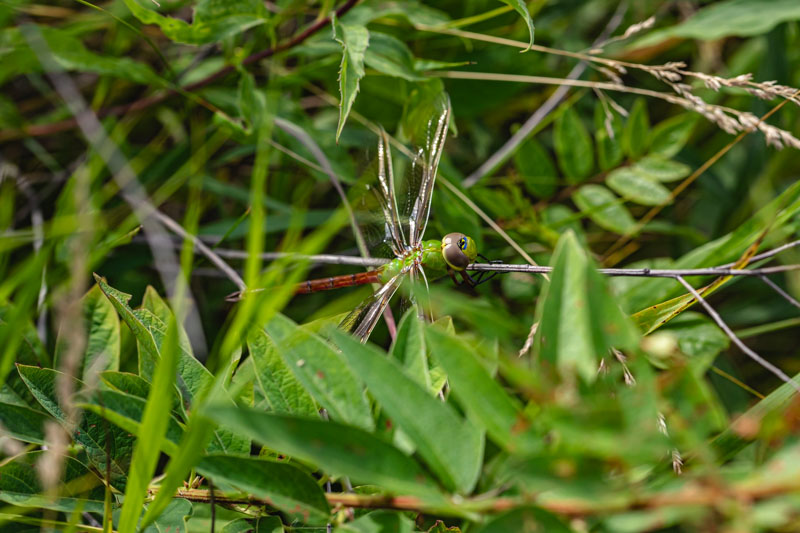
Common Green Darner
(Anax junius)
| D79A0053 | 6720x4480 |
| Image Details | Field Reference Details |
| Camera | Canon EOS 5D Mk IV |
| Lens | EF100mm f/2.8 Macro USM |
| ISO | 400 |
| Aperture | f/6.3 |
| Shutter | 1/1250 |
| Wings | Transparent, strong venation, held forward when perched |
| Thorax | Bright green, often with bluish shoulder stripes |
| Abdomen | Slender, bluish to purplish with tapering tail |
| Eyes | Wraparound green, covering most of the head |
| Range | Throughout North America |
| Habitat | Ponds, marshes, fields, large water bodies |
| Flight Style | Strong, steady, capable of long-distance migration |
| Behavior | Frequently airborne, rarely seen perching for long |
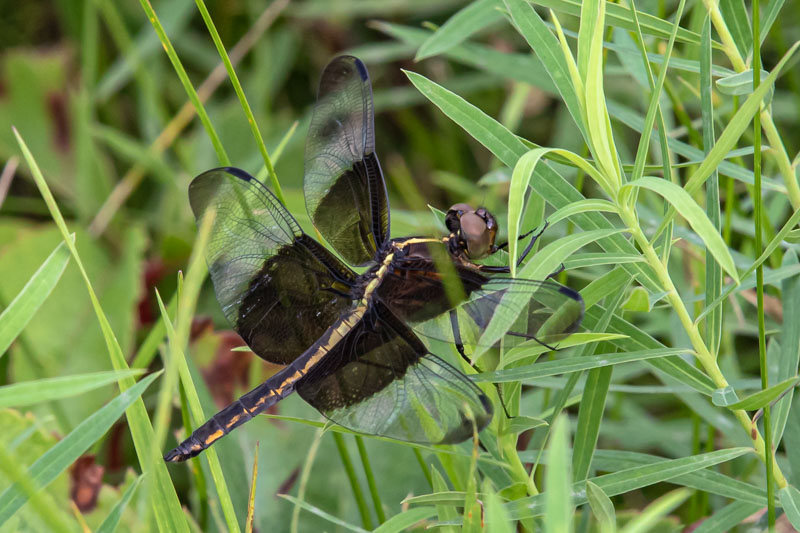
Widow Skimmer
(Libellula luctuosa)
| _21A2259 | 2151x1434 |
| Image Details | Field Reference Details |
| Camera | Canon EOS 5D Mk IV |
| Lens | EF70-200mm f/2.8L IS II USM |
| ISO | 1250 |
| Aperture | f/13.0 |
| Shutter | 1/125 |
| Wings | Clear with black at the base, brown tips. |
| Body | Powder blue abdomen with dark markings |
| Eyes | Dark brown to black |
| Range | Throughout the U.S. except higher elevations. Southern Canada and Northern Mexico. |
| Habitat | Large bodies of water, still or slow moving ponds. |
| Perching | Long thin leaves, stems or low branches near shoreline. |
| Flight Style | Gliding and hovering, males patrol low over open water. Juveniles and females are more erratic to avoid males and predators. |
Damselflies
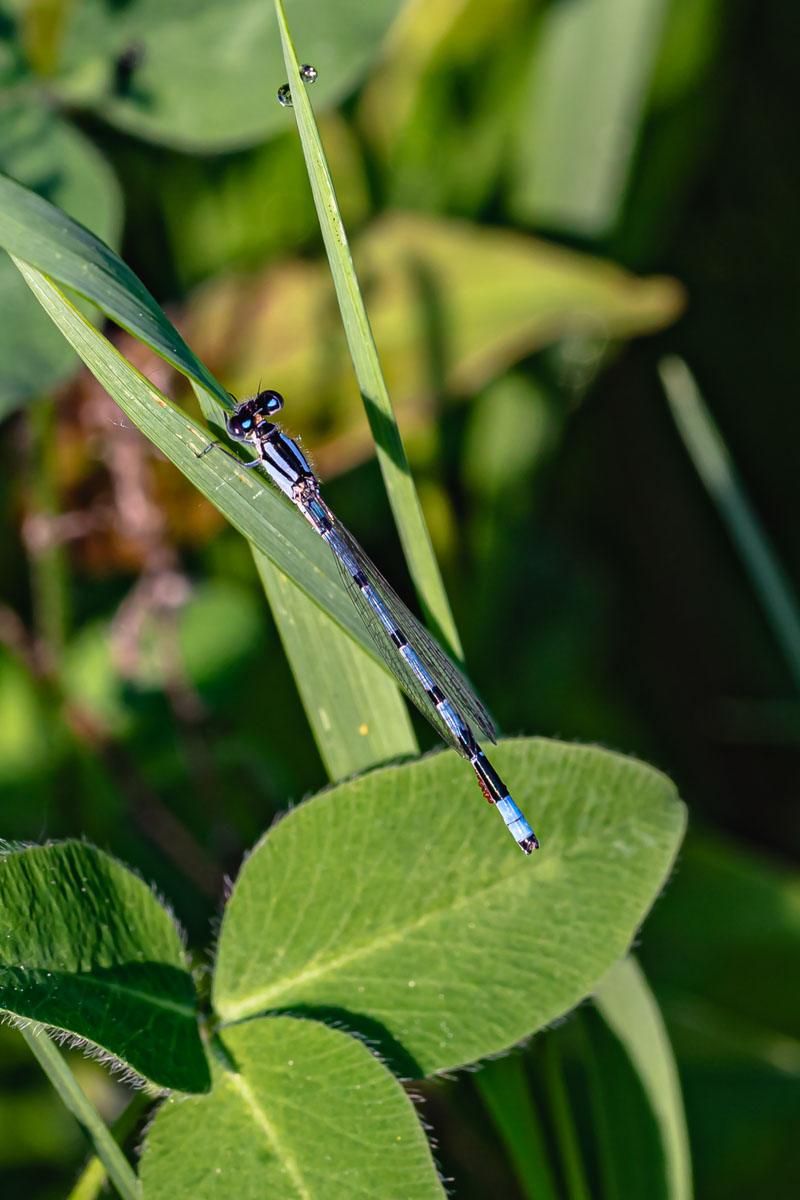
Common Blue Damselfly
Blue-form female
(Enallagma cyathigerum)
| _21A1640 | 1849x2773 |
| Image Details | Field Reference Details |
| Camera | Canon EOS 5D Mk IV |
| Lens | EF100mm f/2.8L Macro IS USM |
| ISO | 200 |
| Aperture | f/13.0 |
| Shutter | 1/125 |
| Wings | Clear with a small dark spot |
| Body | Segment 2 has a distinct "U" shape. Males: Slender, blue with black bands. Females: green-blue or brown. |
| Eyes | Blue with a thin black top line |
| Range | Northern U.S. and Canada |
| Habitat | Ponds, marshes, slow-moving streams, grassy fields near water. |
| Perching | Likes swaying tall grasses or twigs; often perches in open sunlight. |
| Flight Style | Fluttery, slow |
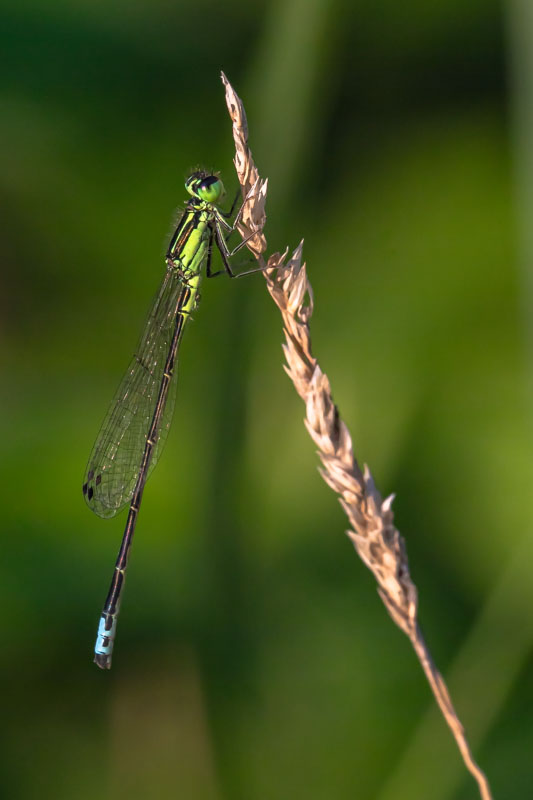
Eastern Forktail
(Ischnura verticalis)
| D79A0192 | 2327x3490 |
| Image Details | Field Reference Details |
| Camera | Canon EOS 5D Mk IV |
| Lens | EF100mm f/2.8L Macro IS USM |
| ISO | 400 |
| Aperture | f/13.0 |
| Shutter | 1/400 |
| Wings | Clear with a small dark spot | |
| Body | Segment 8 has a blue abdominal tip. Green thorax. Black abdomen. | |
| Eyes | Blue or green | |
| Range | Widespread in North America | |
| Habitat | Patches of dense vegetation, lakes, marshes, ponds, edges of large rivers | |
| Perching | Prefer low vegetation; leaves, twigs, stems. | |
| Flight Style | Weak. They normally stay within small territorial zones. | |
| Illinois DNR - Eastern Forktail | ||
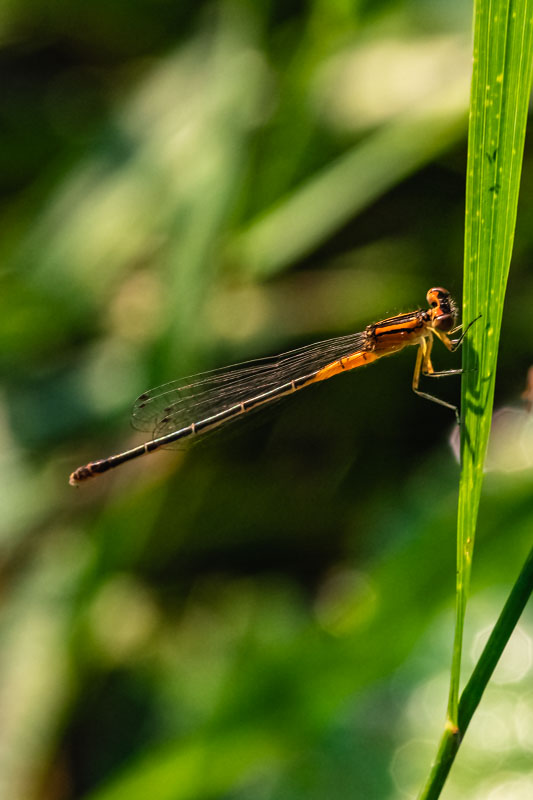
Eastern Forktail
(Ischnura verticalis)
Female, heterochrome phase
| D79A0203 | 2327x3490 |
| Image Details | Field Reference Details |
| Camera | Canon EOS 5D Mk IV |
| Lens | EF100mm f/2.8L Macro IS USM |
| ISO | 1600 |
| Aperture | f/13.0 |
| Shutter | 1/200 |
| Wings | Clear with a small dark spot | |
| Body | Orange thorax. Black abdomen. | |
| Eyes | Orange | |
| Range | Widespread in North America | |
| Habitat | Patches of dense vegetation, lakes, marshes, ponds, edges of large rivers | |
| Perching | Prefer low vegetation; leaves, twigs, stems. | |
| Flight Style | Weak. They normally stay within small territorial zones. | |
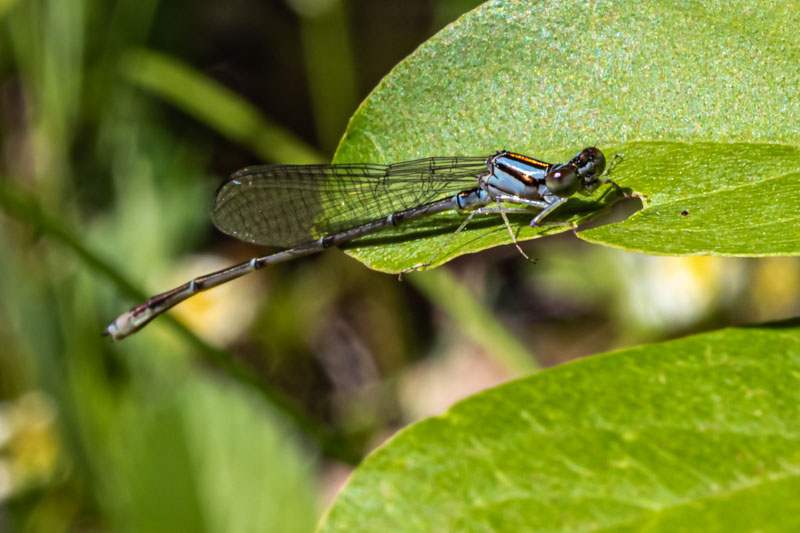
Eastern Forktail
(Ischnura verticalis)
Blue morph
| _21A1520 | 2266x1511 |
| Image Details | Field Reference Details |
| Camera | Canon EOS 5D Mk IV |
| Lens | EF100mm f/2.8L Macro IS USM |
| ISO | 200 |
| Aperture | f/29.0 |
| Shutter | 1/20 |
| Wings | Clear with a small dark spot | |
| Body | Segment 8 has a blue abdominal tip. Blue morph, though normally green. Black abdomen. | |
| Eyes | Blue or green | |
| Range | Widespread in North America | |
| Habitat | Patches of dense vegetation, lakes, marshes, ponds, edges of large rivers | |
| Perching | Prefer low vegetation; leaves, twigs, stems. | |
| Flight Style | Weak. They normally stay within small territorial zones. | |
| BugGuide - Eastern Forktail | ||
| Life on CSG Pond - Eastern Forktail | ||
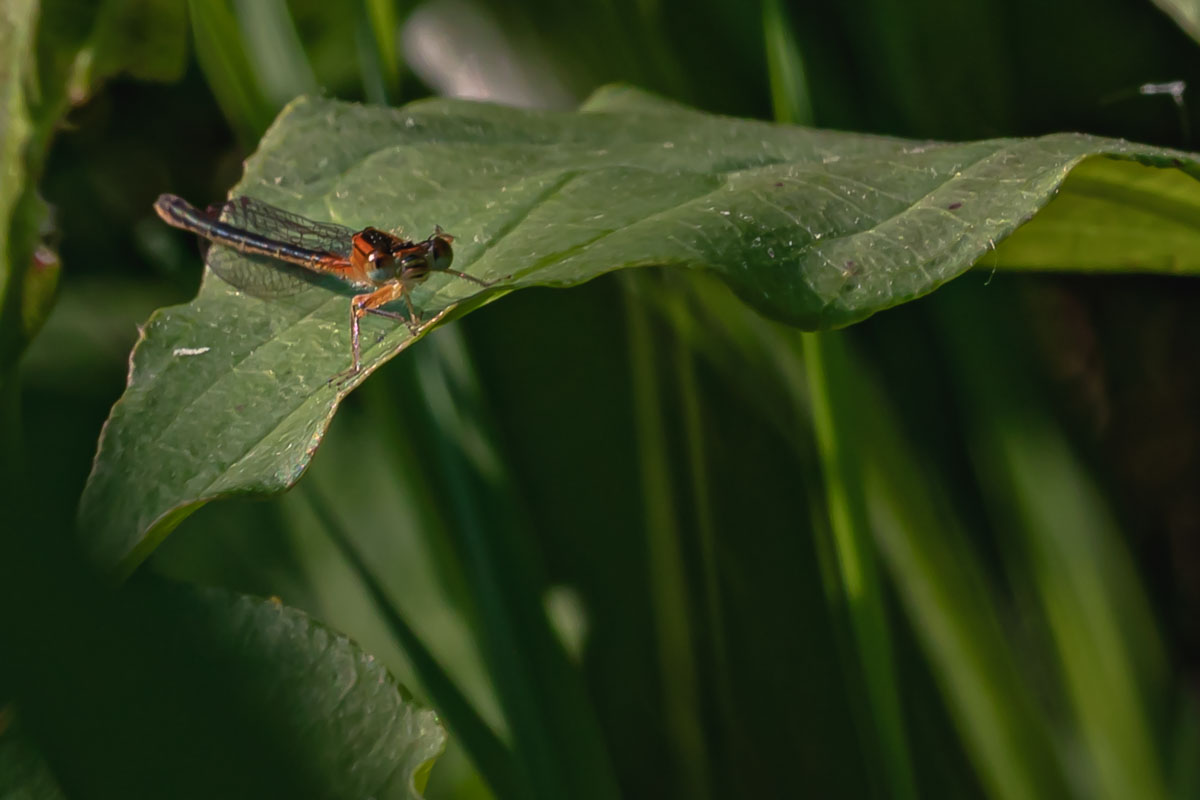
Photo ID: _21A1646
Common Blue Damselfly
Brown-form female
(Enallagma cyathigerum)
| _21A1646 | 1573x1049 |
| Image Details | Field Reference Details |
| Camera | Canon EOS 5D Mk IV |
| Lens | EF100mm f/2.8L Macro IS USM |
| ISO | 200 |
| Aperture | f/16.0 |
| Shutter | 1/125 |
| Wings | Clear with a small dark spot |
| Body | Segment 2 has a distinct "U" shape. Females: green-blue or brown. |
| Eyes | Blue with a thin black top line |
| Range | Northern U.S. and Canada |
| Habitat | Ponds, marshes, slow-moving streams, grassy fields near water. |
| Perching | Likes swaying tall grasses or twigs; often perches in open sunlight. |
| Flight Style | Fluttery, slow |
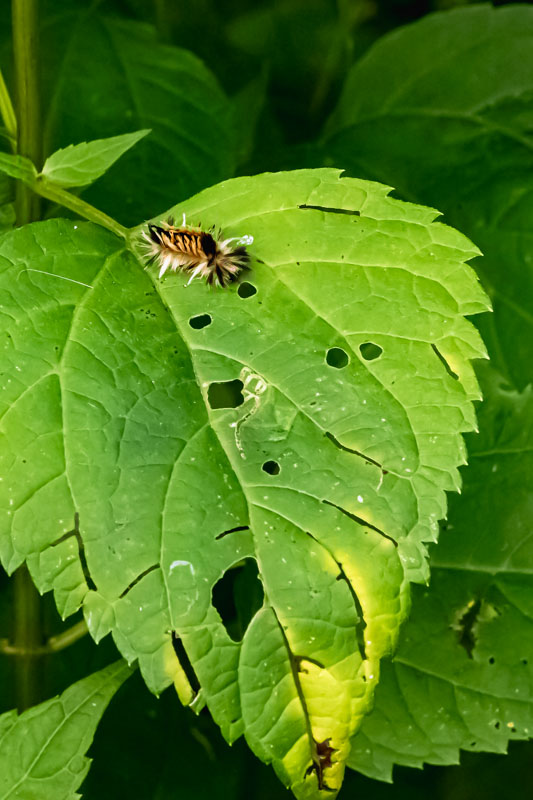
Milkweed Tussock Moth caterpillar
(Euchaetes egle)
| _21A2381 | 2068x3102 |
| Image Details | Field Reference Details |
| Camera | Canon EOS 5D Mk IV |
| Lens | EF70-200mm f/2.8L IS II USM |
| ISO | 12800 |
| Aperture | f/13.0 |
| Shutter | 1/500 |
| Coloration | Alternating tufts of black, white, and orange hairs across segments |
| Body | Hairy, soft-bodied; black head hidden beneath forward tufts |
| Defense | Hairs can cause mild skin irritation in sensitive individuals |
| Host Plants | Primarily milkweed; also dogbane and other Asclepias relatives |
| Range | Eastern and central North America |
| Habitat | Fields, roadsides, and meadows with abundant milkweed |
| Behavior | Often found in groups when young; become solitary as they mature |
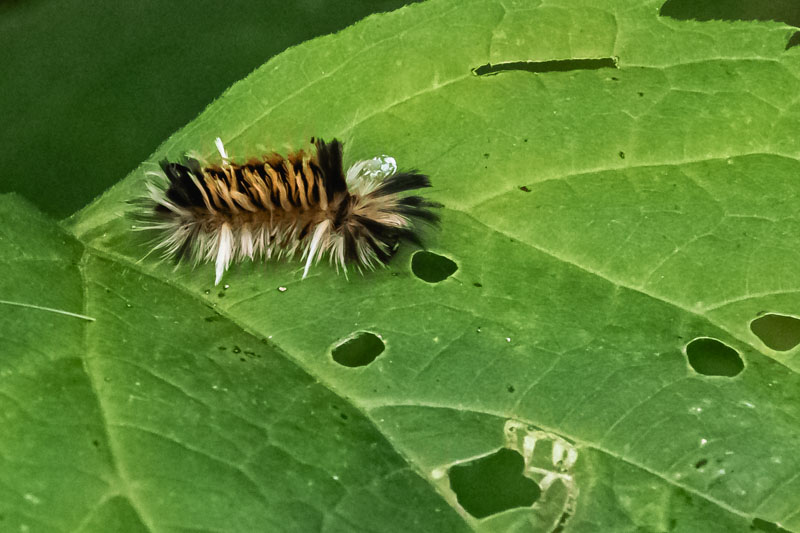
Milkweed Tussock Moth caterpillar
(Euchaetes egle)
| _21A2380 | 2068x3102 |
| Image Details | Field Reference Details |
| Camera | Canon EOS 5D Mk IV |
| Lens | EF70-200mm f/2.8L IS II USM |
| ISO | 10000 |
| Aperture | f/13.0 |
| Shutter | 1/500 |
| Coloration | Alternating tufts of black, white, and orange hairs across segments |
| Body | Hairy, soft-bodied; black head hidden beneath forward tufts |
| Defense | Hairs can cause mild skin irritation in sensitive individuals |
| Host Plants | Primarily milkweed; also dogbane and other Asclepias relatives |
| Range | Eastern and central North America |
| Habitat | Fields, roadsides, and meadows with abundant milkweed |
| Behavior | Often found in groups when young; become solitary as they mature |
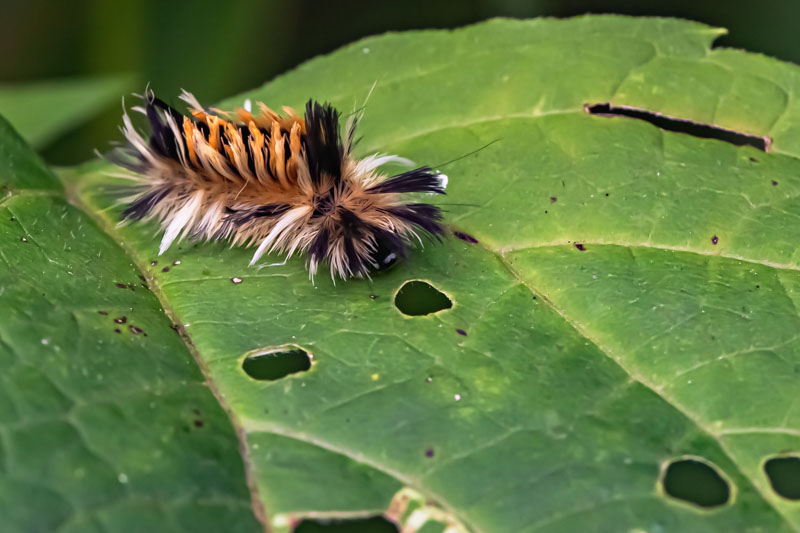
Milkweed Tussock Moth caterpillar
(Euchaetes egle)
| D79A0222 | 1861x1241 |
| Image Details | Field Reference Details |
| Camera | Canon EOS 5D Mk IV |
| Lens | EF100mm f/2.8L Macro IS USM |
| ISO | 12800 |
| Aperture | f/11.0 |
| Shutter | 1/1600 |
| Coloration | Alternating tufts of black, white, and orange hairs across segments |
| Body | Hairy, soft-bodied; black head hidden beneath forward tufts |
| Defense | Hairs can cause mild skin irritation in sensitive individuals |
| Host Plants | Primarily milkweed; also dogbane and other Asclepias relatives |
| Range | Eastern and central North America |
| Habitat | Fields, roadsides, and meadows with abundant milkweed |
| Behavior | Often found in groups when young; become solitary as they mature |
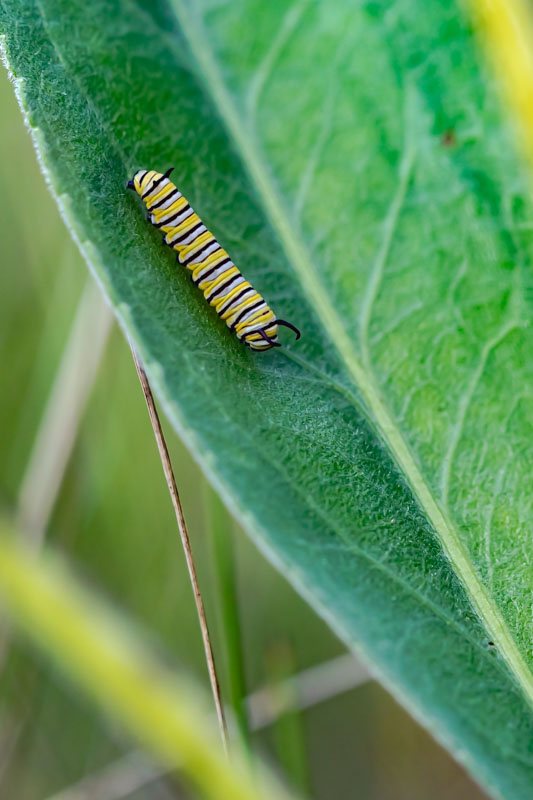
Monarch Butterfly caterpillar
(Danaus plexippus)
| D79A0327 | 2445x3667 |
| Image Details | Field Reference Details |
| Camera | Canon EOS 5D Mk IV |
| Lens | EF100mm f/2.8L Macro IS USM |
| ISO | 800 |
| Aperture | f/5.0 |
| Shutter | 1/125 |
| Coloration | Bold black, white, and yellow bands along the entire body |
| Body | Smooth, cylindrical body with two pairs of black tentacle-like filaments (front and rear) |
| Defense | Sequesters toxins from milkweed, making it distasteful to predators |
| Host Plants | td>Milkweed species (Asclepias spp.)|
| Range | North, Central, and South America; migratory in North America |
| Habitat | Open fields, meadows, and roadsides with abundant milkweed |
| Behavior | Feeds almost exclusively on milkweed; grows through 5 instar stages before pupating |
Ladybug (Ladybird)
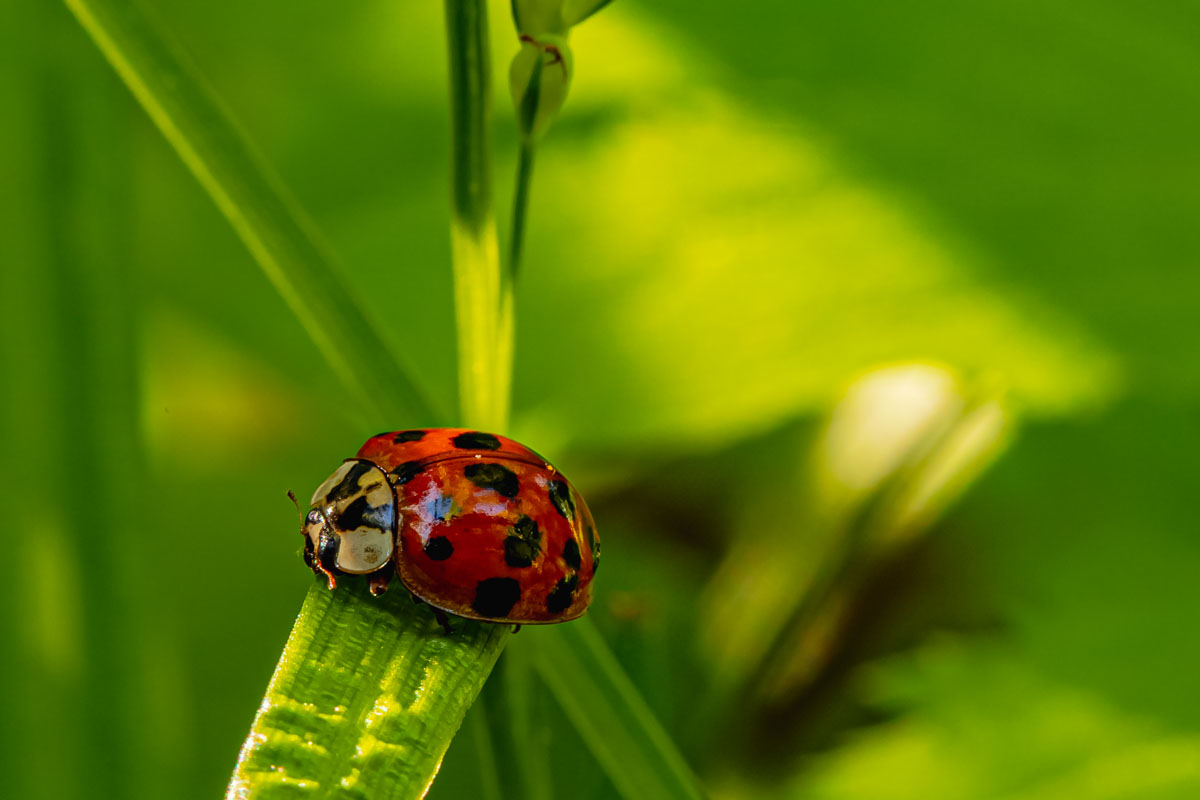
Photo ID: _21A1534
2485x1657
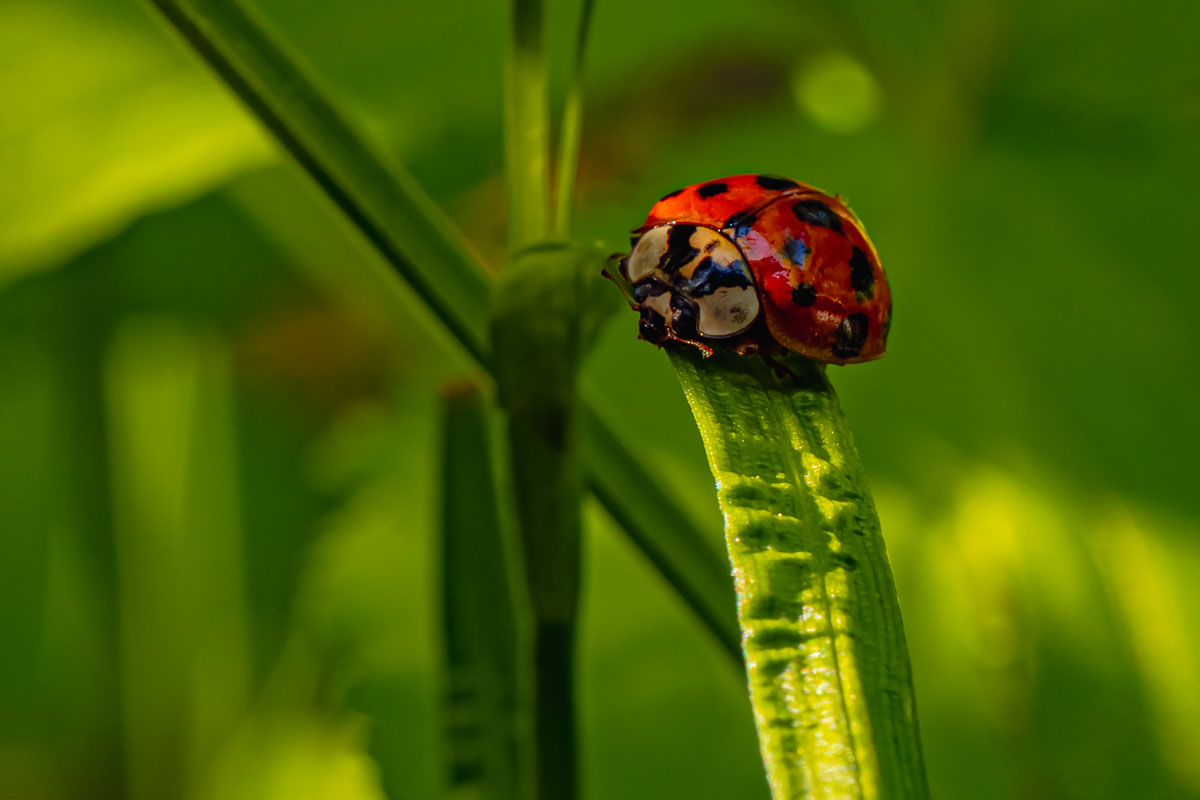
Photo ID: _21A1535
2485x1657
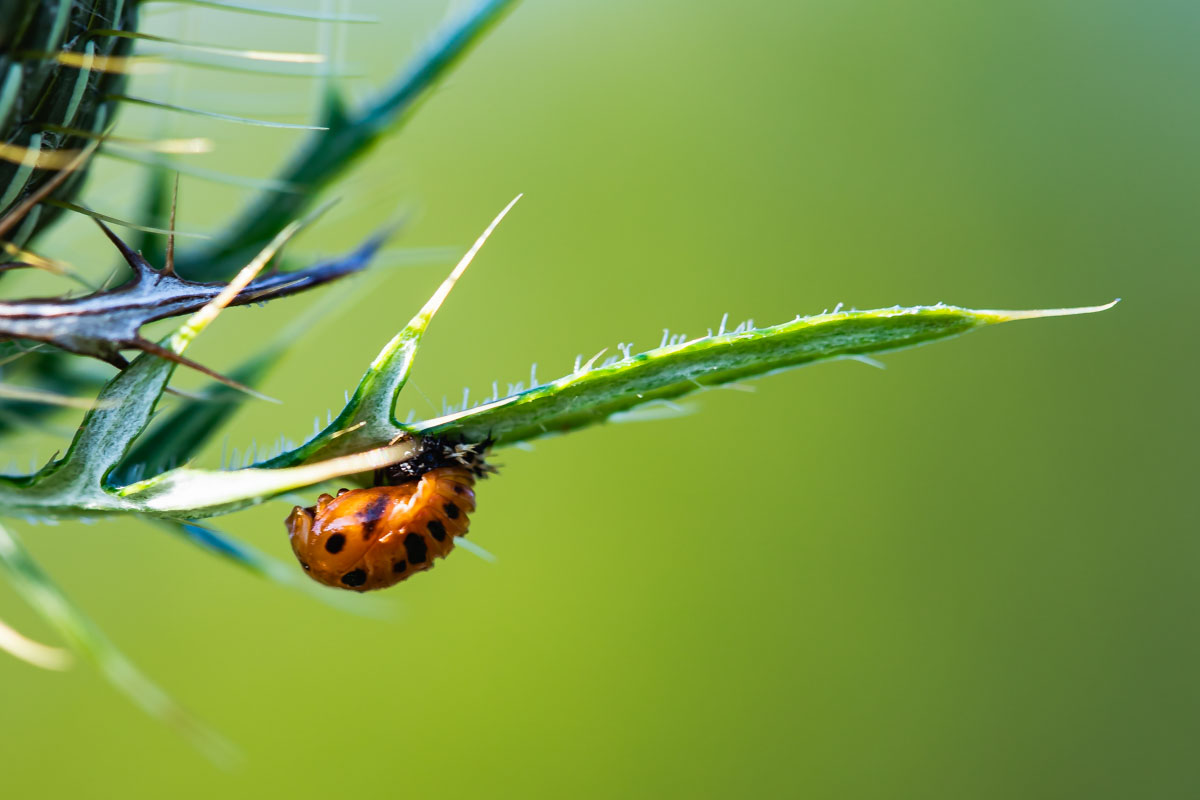
Photo ID: D79A4836
Coccinellidae
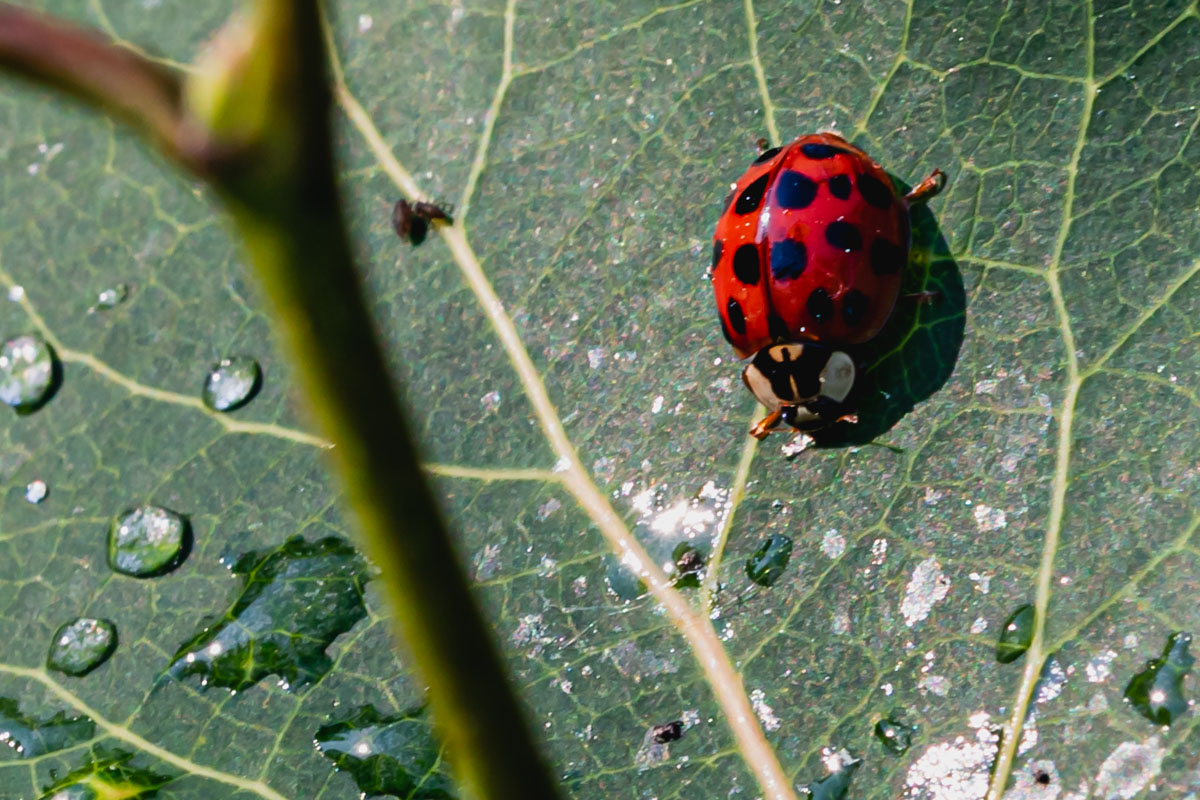
Photo ID: _21A1650
1201x800
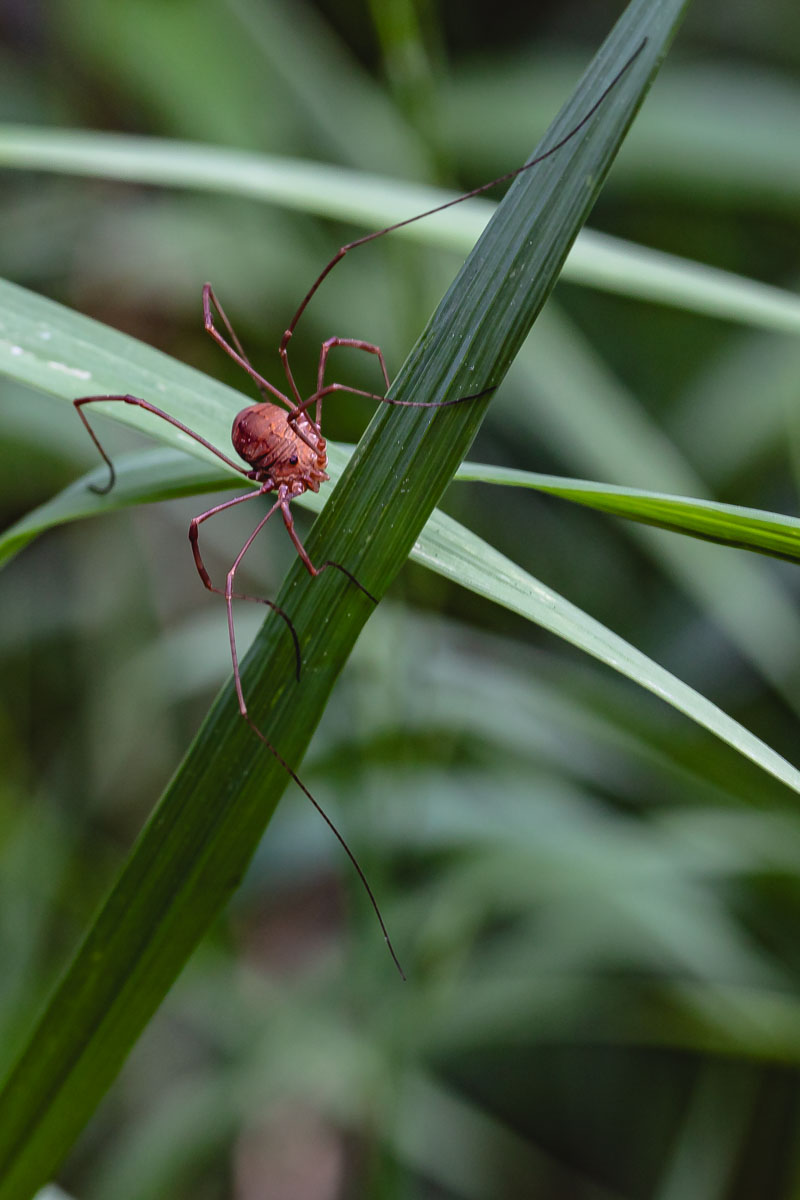
Harvestman
(Opiliones)
| _21A1700 | 3765x2510 |
| Image Details | Field Reference Details |
| Camera | Canon EOS 5D Mk IV |
| Lens | EF100mm f/2.8L Macro IS USM |
| ISO | 200 |
| Aperture | f/9.0 |
| Shutter | 1/60 |
| Body | Small, rounded body with no visible waist between cephalothorax and abdomen; color varies from brown to reddish with possible dorsal patterns. |
| Legs | Extremely long and slender; often held outstretched; legs may detach easily as a defense mechanism. |
| Eyes | Two small eyes set close together on a central raised turret. |
| Range | Worldwide, especially in temperate and tropical regions. |
| Habitat | Moist forest floors, under logs, leaf litter, rocks, and sometimes on vegetation. |
| Behavior | Not venomous; scavenges for small insects, decaying plant and animal matter; sometimes seen in large groups. |
| Defenses | May release a pungent odor or shed a leg to escape predators. |
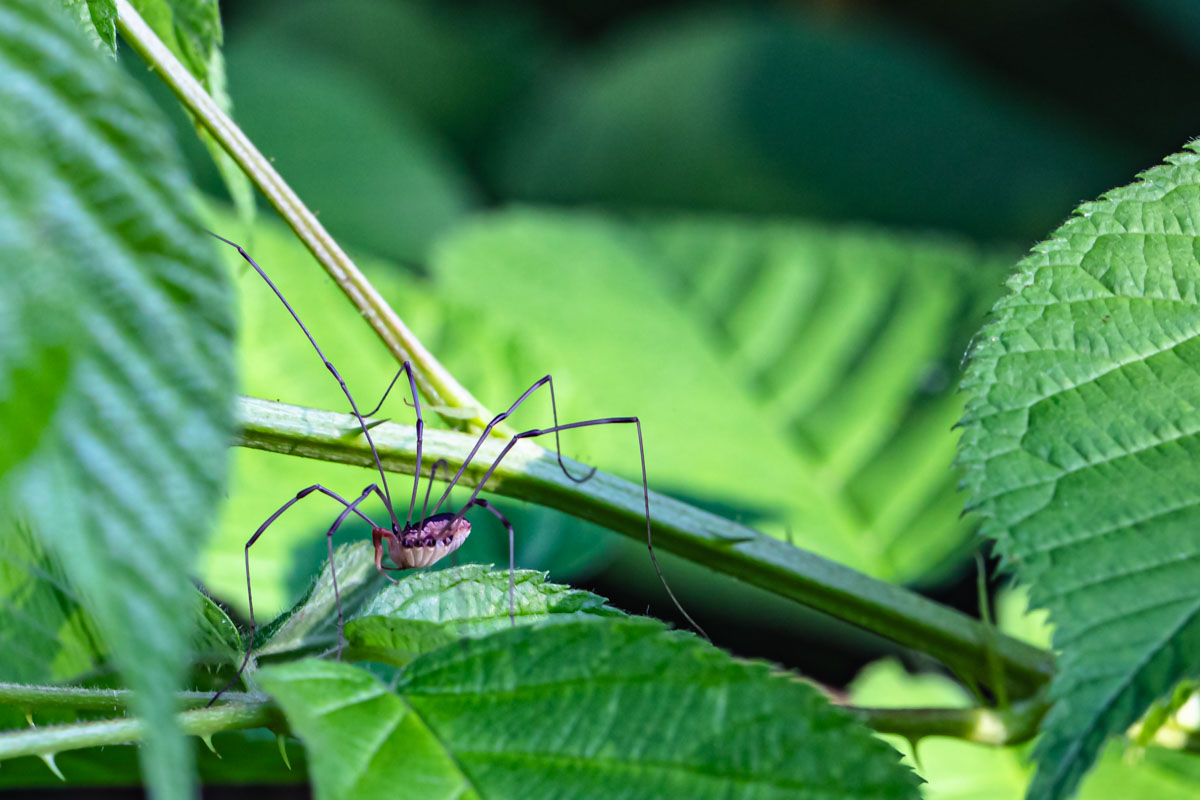
Harvestman
(Opiliones)
| _21A1700 | 3765x2510 |
| Image Details | Field Reference Details |
| Camera | Canon EOS 5D Mk IV |
| Lens | EF100mm f/2.8L Macro IS USM |
| ISO | 800 |
| Aperture | f/14.0 |
| Shutter | 1/60 |
| Body | Small, rounded body with no visible waist between cephalothorax and abdomen; color varies from brown to reddish with possible dorsal patterns. |
| Legs | Extremely long and slender; often held outstretched; legs may detach easily as a defense mechanism. |
| Eyes | Two small eyes set close together on a central raised turret. |
| Range | Worldwide, especially in temperate and tropical regions. |
| Habitat | Moist forest floors, under logs, leaf litter, rocks, and sometimes on vegetation. |
| Behavior | Not venomous; scavenges for small insects, decaying plant and animal matter; sometimes seen in large groups. |
| Defenses | May release a pungent odor or shed a leg to escape predators. |
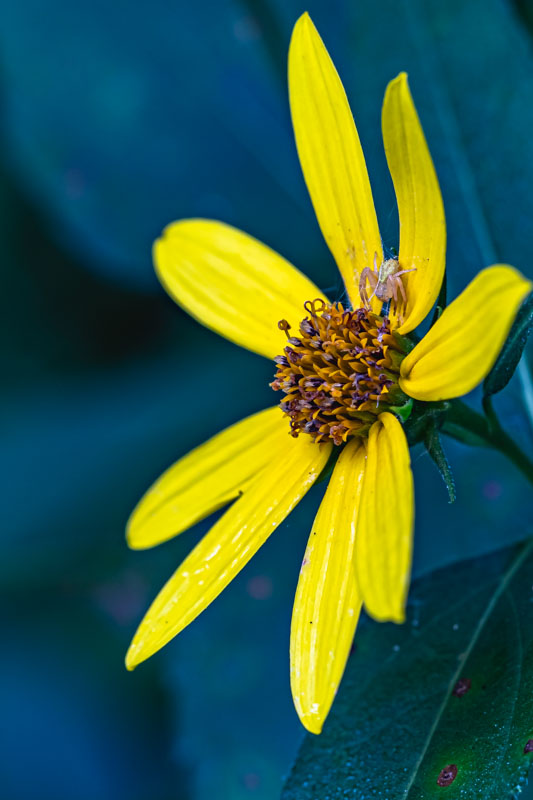
Goldenrod Crab Spider
(Misumena vatia)
| D79A0274 | 2787x4181 |
| Image Details | Field Reference Details |
| Camera | Canon EOS 5D Mk IV |
| Lens | EF100mm f/2.8L Macro IS USM |
| ISO | 200 |
| Aperture | f/8.0 |
| Shutter | 1/8 |
| Coloration | White to yellow (slow color change over days); females often with red side stripes |
| Body | Flattened, crab-like; front legs long and raptorial; no capture web |
| Sex Differences | Females large (up to ~10 mm), variable color; males much smaller (~3–5 mm), darker legs |
| Hunting / Prey | Ambush predator on flowers; takes bees, flies, butterflies—often larger than itself |
| Camouflage | Matches flower color (white ↔ yellow) for concealment on asters, daisies, goldenrod |
| Habitat | Meadows, roadsides, gardens—especially where composite flowers are abundant |
| Range | Widespread across North America and Eurasia |
| Season | Most visible on blooms late spring through fall; egg sacs guarded by females |
| Notes | Often seen perched near flower centers; will shift spots as blooms age |
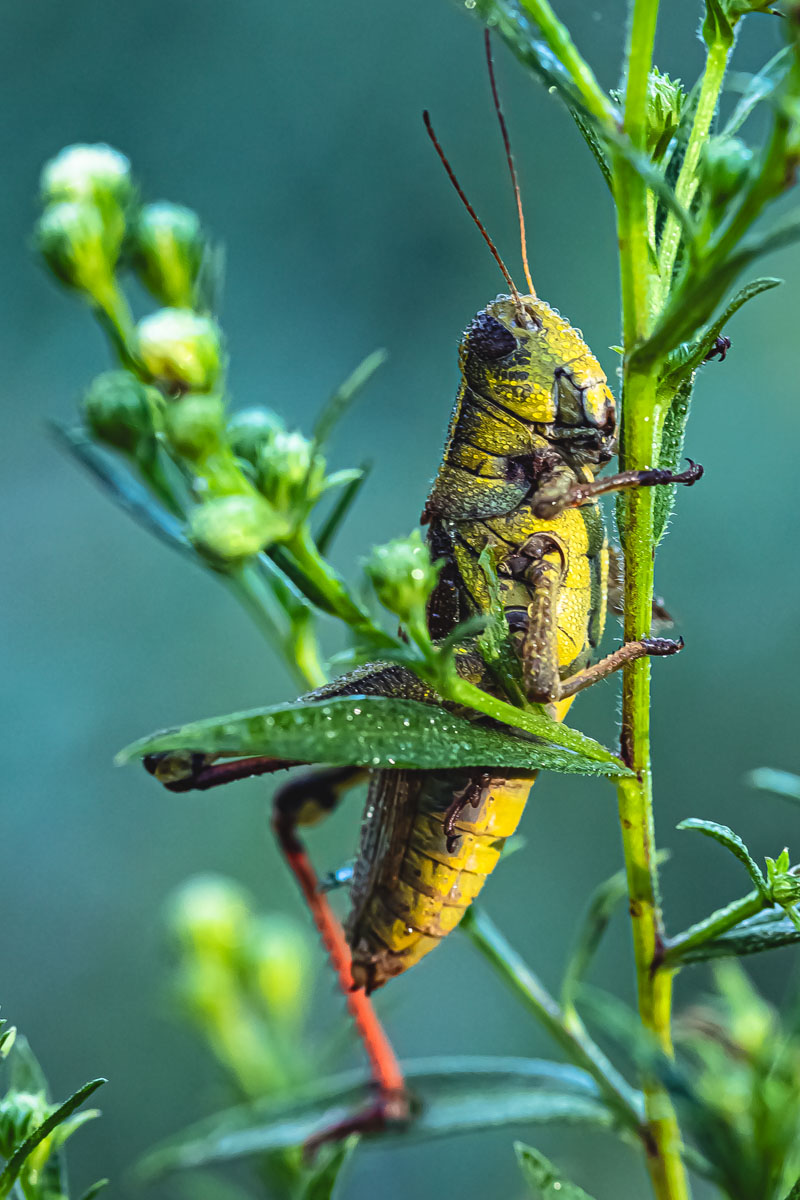
Red-legged Grasshopper
Photo ID: D79A0489
2660x3990
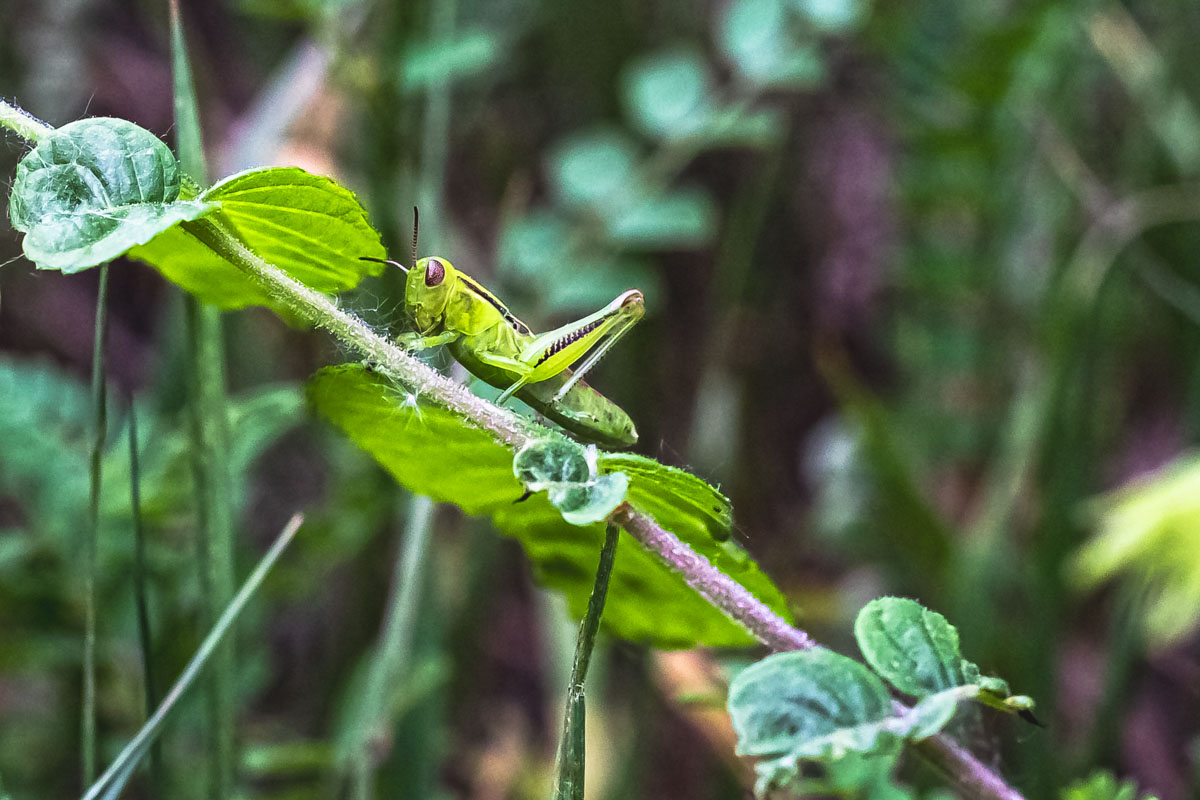
Two-striped Grasshopper
Photo ID: D79A1617
2194x1234

Tree Cricket nymph
(Grylidae)
| D79A0354 | 3771x2514 |
| Image Details | Field Reference Details |
| Camera | Canon EOS 5D Mark IV |
| Lens | EF100mm f/2.8L Macro IS USM |
| ISO | 6400 |
| Aperture | f/8.0 |
| Shutter | 1/200 sec |
| Common Name | Tree Cricket (nymph) |
| Scientific Name | Oecanthus sp. |
| Size | Body length ~5–12 mm at nymph stage |
| Key ID Marks | Slender pale green body; extremely long thread-like antennae often 2–3× body length; hind legs adapted for jumping. |
| Head | Small and rounded; pale green; long antennae bases visible. |
| Thorax | Slim with light ridging; legs long and delicate. |
| Abdomen | Tapered; pale green; wing buds small or absent in early instars. |
| Antennae | Filiform (thread-like), pale to slightly darker at tips, greatly exceeding body length. |
| Legs | Long, pale green; hind femora thickened for jumping. |
| Behavior / Diet | Feeds on plant material, pollen, and small insects; often active at night. |
| Season | Late spring through early fall; adults appear later in summer. |
| Habitat | Meadows, shrubs, gardens; often on leaves and stems. |
| Range | Widespread across North America. |
| Similar Species | Katydid nymphs (shorter antennae relative to body), meadow katydids (stockier build); lacewings have wings as adults and shorter legs. |
| Notes | Adults are known for their clear, rhythmic songs; species ID often requires song analysis or close examination. |
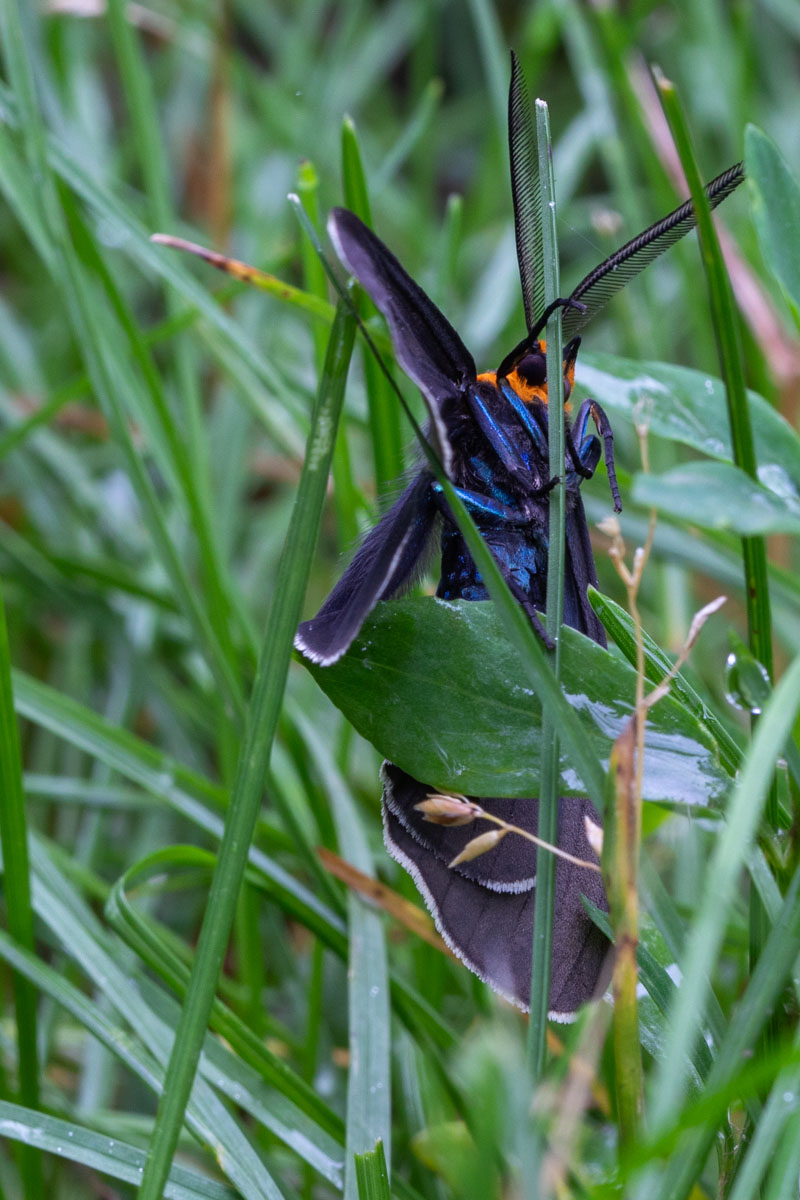
Virginia Ctenucha
(Ctenucha Virginica)
| _21A1663 | 1551x2326 |
| Image Details | Field Reference Details |
| Camera | Canon Canon EOS 5D Mark IV |
| Lens | EF100mm f/2.8L Macro IS USM |
| ISO | 200 |
| Aperture | f/9.0 |
| Shutter | 1/30 |
| Wings | Forewings dark brown to black with white edge; hindwings slightly lighter. Both appear velvety, with no bold patterns. |
| Body | Metallic blue-green, often iridescent. Slender form with long legs. |
| Head/Collar | Bright orange to yellow |
| Antennae | Comb-like, black (pectinate), more feathery in males. |
| Size | Wingspan 40–50 mm (about 1.5–2 inches). |
| Habitat | Meadows, fields, woodland edges; often seen visiting flowers during the day. |
| Range | Eastern North America, from Canada through the Midwest and eastern U.S. |
| Notes | Diurnal moth; sometimes mistaken for a wasp or beetle in flight. Larvae feed on grasses and sedges. |

Virginia Ctenucha
(Ctenucha Virginica)
| _21A1660 | 1608x2412 |
| Image Details | Field Reference Details |
| Camera | Canon Canon EOS 5D Mark IV |
| Lens | EF100mm f/2.8L Macro IS USM |
| ISO | 200 |
| Aperture | f/9.0 |
| Shutter | 1/30 |
| Wings | Forewings dark brown to black with white edge; hindwings slightly lighter. Both appear velvety, with no bold patterns. |
| Body | Metallic blue-green, often iridescent. Slender form with long legs. |
| Head/Collar | Bright orange to yellow |
| Antennae | Comb-like, black (pectinate), more feathery in males. |
| Size | Wingspan 40–50 mm (about 1.5–2 inches). |
| Habitat | Meadows, fields, woodland edges; often seen visiting flowers during the day. |
| Range | Eastern North America, from Canada through the Midwest and eastern U.S. |
| Notes | Diurnal moth; sometimes mistaken for a wasp or beetle in flight. Larvae feed on grasses and sedges. |
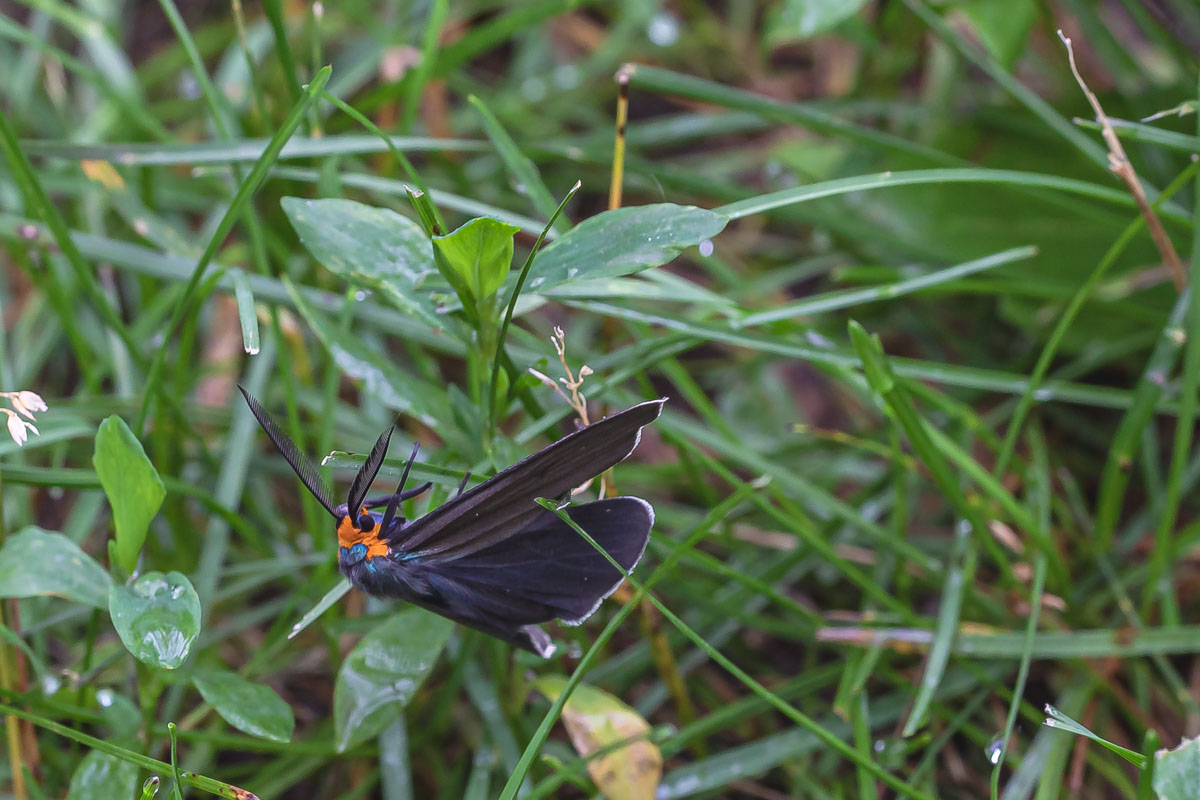
Virginia Ctenucha
(Ctenucha Virginica)
| _21A1656 | 1003x1505 |
| Image Details | Field Reference Details |
| Camera | Canon Canon EOS 5D Mark IV |
| Lens | EF100mm f/2.8L Macro IS USM |
| ISO | 200 |
| Aperture | f/9.0 |
| Shutter | 1/30 |
| Wings | Forewings dark brown to black with white edge; hindwings slightly lighter. Both appear velvety, with no bold patterns. |
| Body | Metallic blue-green, often iridescent. Slender form with long legs. |
| Head/Collar | Bright orange to yellow |
| Antennae | Comb-like, black (pectinate), more feathery in males. |
| Size | Wingspan 40–50 mm (about 1.5–2 inches). |
| Habitat | Meadows, fields, woodland edges; often seen visiting flowers during the day. |
| Range | Eastern North America, from Canada through the Midwest and eastern U.S. |
| Notes | Diurnal moth; sometimes mistaken for a wasp or beetle in flight. Larvae feed on grasses and sedges. |

Yellow-bearded Hammertail
(Efferia pogonias)
| _21A2883 | 3305x2203 |
| Image Details | Field Reference Details |
| Camera | Canon Canon EOS 5D Mark IV |
| Lens | EF100mm f/2.8L Macro IS USM |
| ISO | 8000 |
| Aperture | f/13.0 |
| Shutter | 1/800 |
| Group | Fly (Order Diptera) |
| Family | Asilidae — Robber Flies |
| Common Name | Bearded Robber Fly |
| Size | Approx. 18–28 mm (typical for Efferia) |
| Key Marks | Dark, robust body; yellow-golden mystax (beard); long spiny legs; distinct white terminal abdominal segments; strong piercing proboscis. |
| Behavior | Perches on grass or stems and sallies to capture other insects in flight; returns to perch to feed. |
| Habitat | Open, grassy or sandy areas, prairies, field edges, disturbed ground. |
| Seasonality (MN) | Late June–September (mid-summer peak). |
| Similar Species | Promachus rufipes (larger, browner, usually no crisp white tail); Efferia aestuans (silvery, not starkly white, last segments); Laphria spp. (bumblebee mimics, fuzzier). |
| ID Confidence | Genus certain (Efferia); species probable (pogonias) based on white-tipped abdomen and mystax color. |
| Notes | For definitive species ID, experts inspect terminalia and wing venation; close dorsal and lateral photos of the abdominal tip and face are most helpful. |
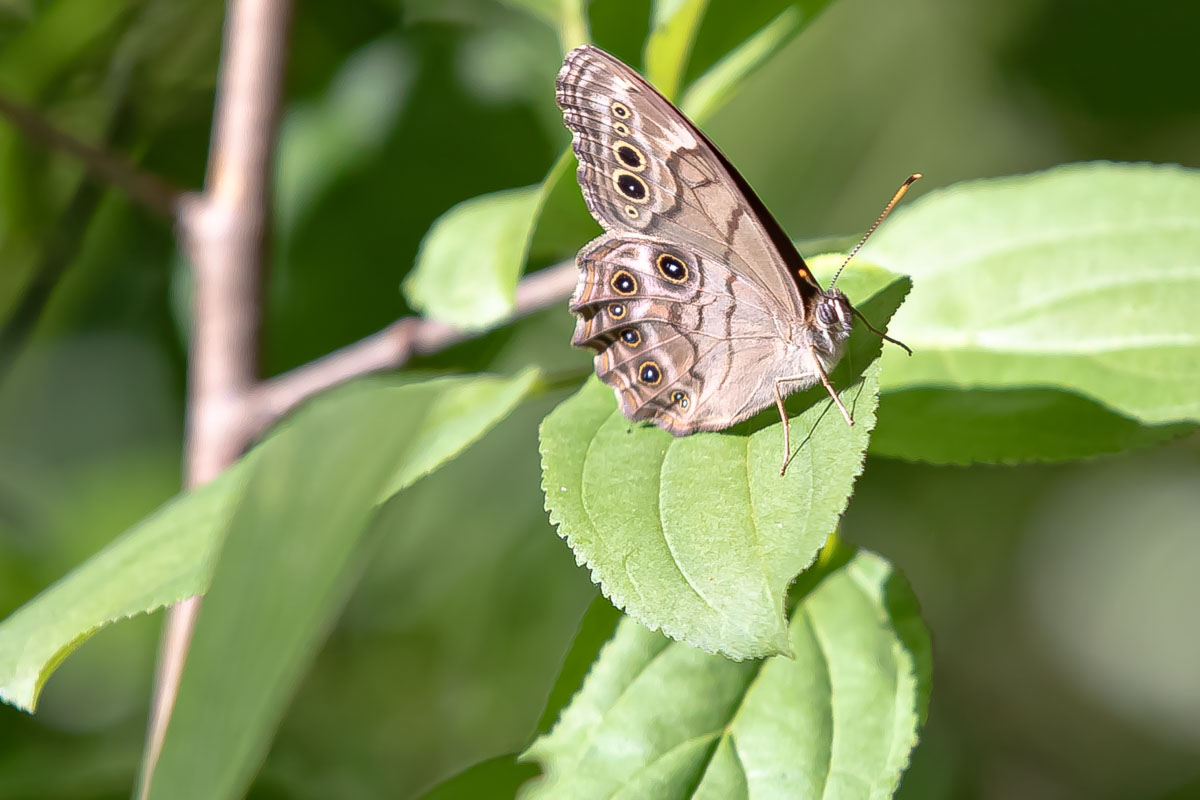
Northern Pearly-eye butterfly
Photo ID: D79A4109
716x1074
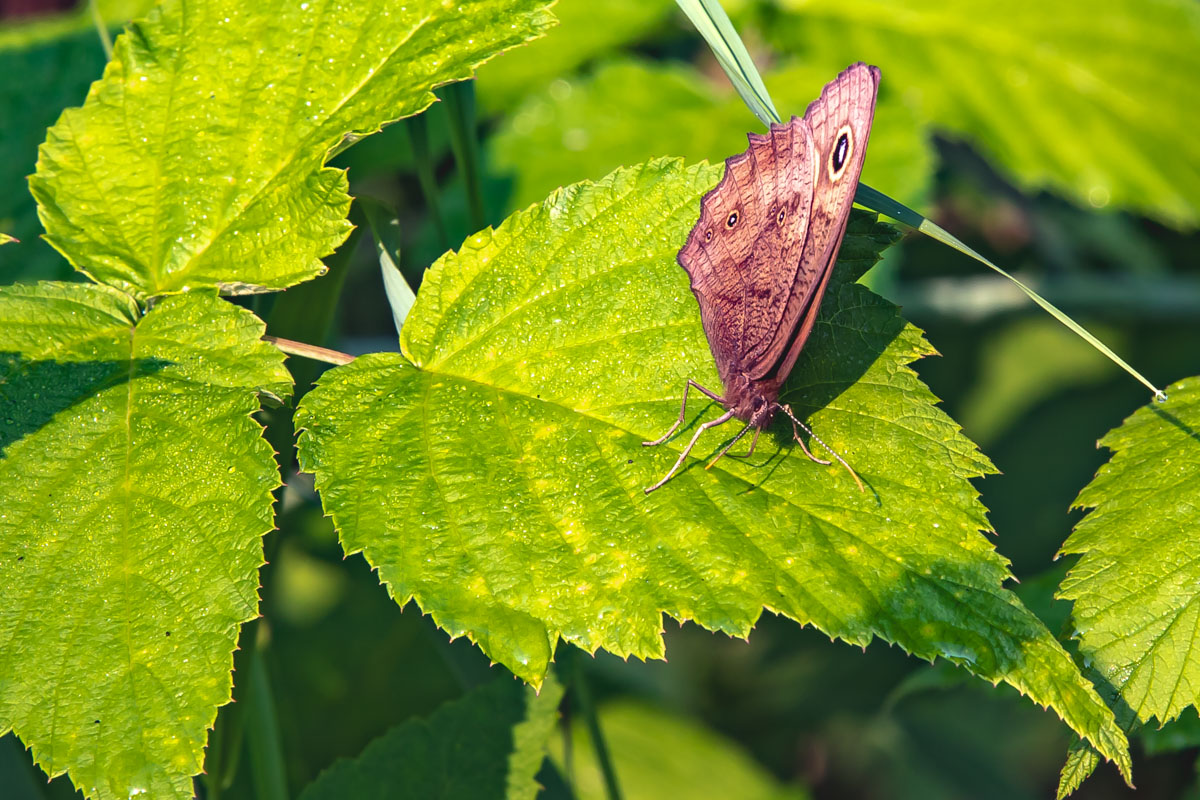
Northern Pearly-eye butterfly
Photo ID: _21A1748
2902x1935
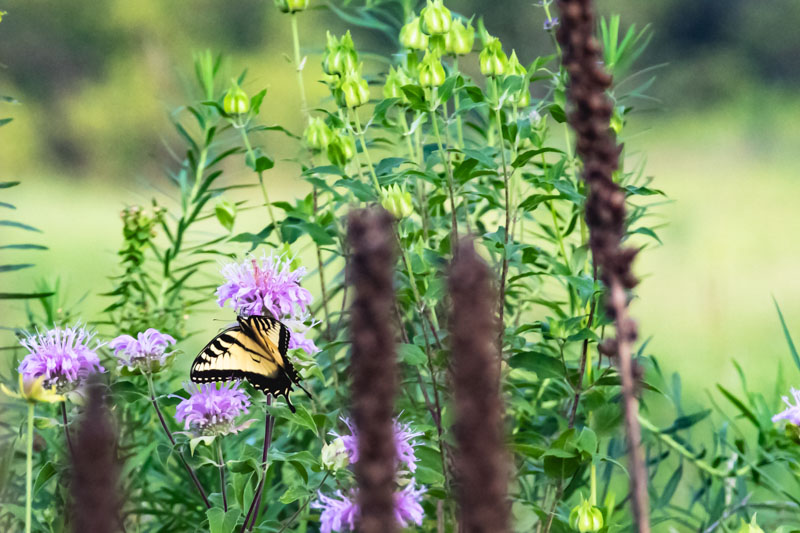
Swallowtail Butterfly
Photo ID: _21A2002
2902x1935
Sharpness
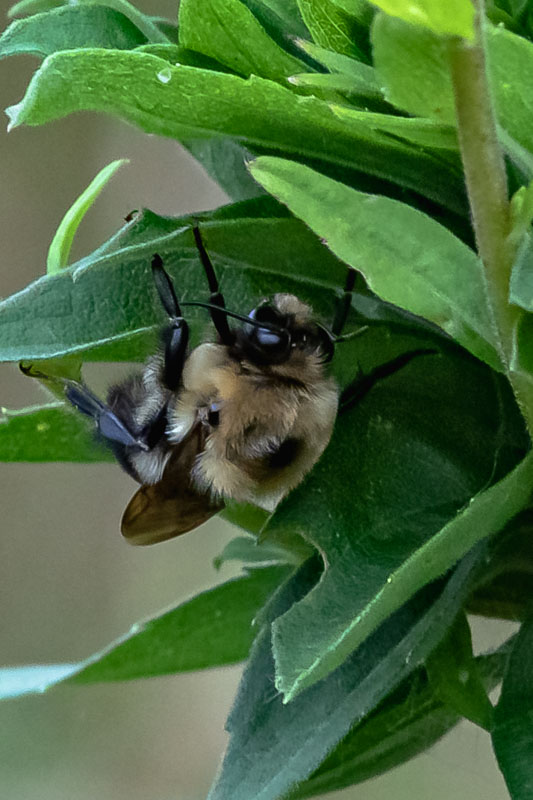
Brown-belted Bumblebee
(Bombus griseocollis)
| _21A2708 | 713x1070 |
| Image Details | Field Reference Details |
| Camera | Canon EOS 5D Mk IV |
| Lens | EF70-200mm f/2.8L IS II USM |
| ISO | 800 |
| Aperture | f/13.0 |
| Shutter | 1/100 |
| Wings | Transparent with fine venation; may show a subtle smoky or amber tint near the base when backlit. |
| Body | Robust and very hairy; thorax pale yellow to golden, abdomen with a distinct brown/black “belt” banding (gives the common name). |
| Eyes | Large, dark (brown to black), set laterally on the head. |
| Range | Widespread across much of North America — common in the northern and central United States and southern Canada. |
| Habitat | Open fields, meadows, gardens, roadsides and edges of woodlands; frequently visits flower-rich areas and pollinator plantings. |
| Perching | Males often rest on flowers, leaves, or stems; may hang upside-down on foliage for short periods while surveying territory. |
| Flight Style | Steady, low-to-medium flight with a characteristic “bumbling” appearance; capable of quick, agile maneuvers when visiting flowers. |
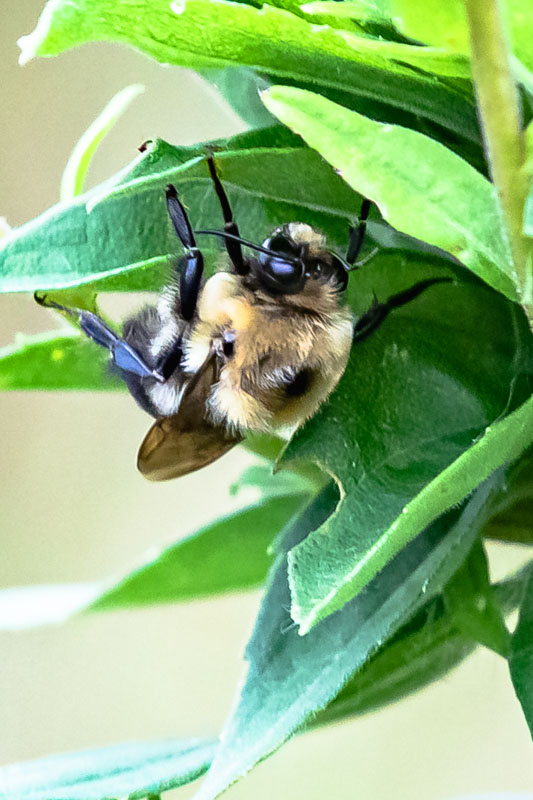
Brown-belted Bumblebee
(Bombus griseocollis)
| _21A2710 | 713x1070 |
| Image Details | Field Reference Details |
| Camera | Canon EOS 5D Mk IV |
| Lens | EF70-200mm f/2.8L IS II USM |
| ISO | 800 |
| Aperture | f/6.3 |
| Shutter | 1/160 |
| Wings | Transparent with fine venation; may show a subtle smoky or amber tint near the base when backlit. |
| Body | Robust and very hairy; thorax pale yellow to golden, abdomen with a distinct brown/black “belt” banding (gives the common name). |
| Eyes | Large, dark (brown to black), set laterally on the head. |
| Range | Widespread across much of North America — common in the northern and central United States and southern Canada. |
| Habitat | Open fields, meadows, gardens, roadsides and edges of woodlands; frequently visits flower-rich areas and pollinator plantings. |
| Perching | Males often rest on flowers, leaves, or stems; may hang upside-down on foliage for short periods while surveying territory. |
| Flight Style | Steady, low-to-medium flight with a characteristic “bumbling” appearance; capable of quick, agile maneuvers when visiting flowers. |
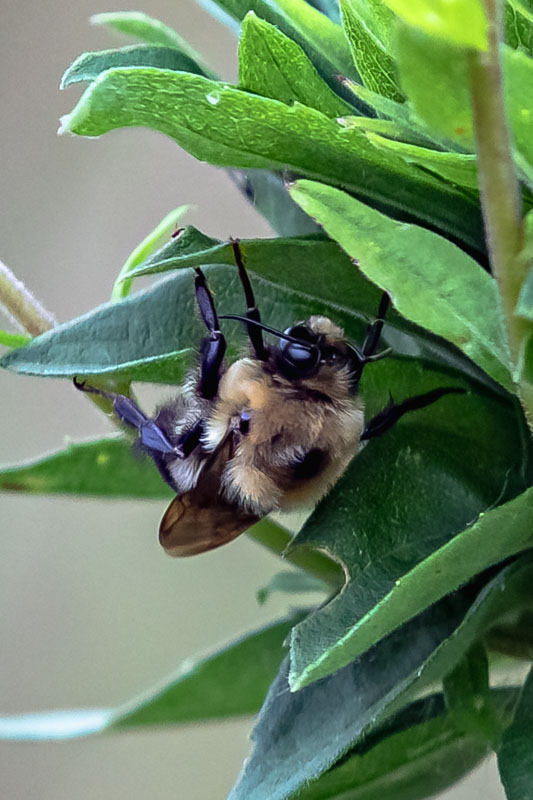
Brown-belted Bumblebee
(Bombus griseocollis)
| _21A2717 | 713X1070 |
| Image Details | Field Reference Details |
| Camera | Canon EOS 5D Mk IV |
| Lens | EF70-200mm f/2.8L IS II USM |
| ISO | 400 |
| Aperture | f/6.3 |
| Shutter | 1/160 |
| Wings | Transparent with fine venation; may show a subtle smoky or amber tint near the base when backlit. |
| Body | Robust and very hairy; thorax pale yellow to golden, abdomen with a distinct brown/black “belt” banding (gives the common name). |
| Eyes | Large, dark (brown to black), set laterally on the head. |
| Range | Widespread across much of North America — common in the northern and central United States and southern Canada. |
| Habitat | Open fields, meadows, gardens, roadsides and edges of woodlands; frequently visits flower-rich areas and pollinator plantings. |
| Perching | Males often rest on flowers, leaves, or stems; may hang upside-down on foliage for short periods while surveying territory. |
| Flight Style | Steady, low-to-medium flight with a characteristic “bumbling” appearance; capable of quick, agile maneuvers when visiting flowers. |
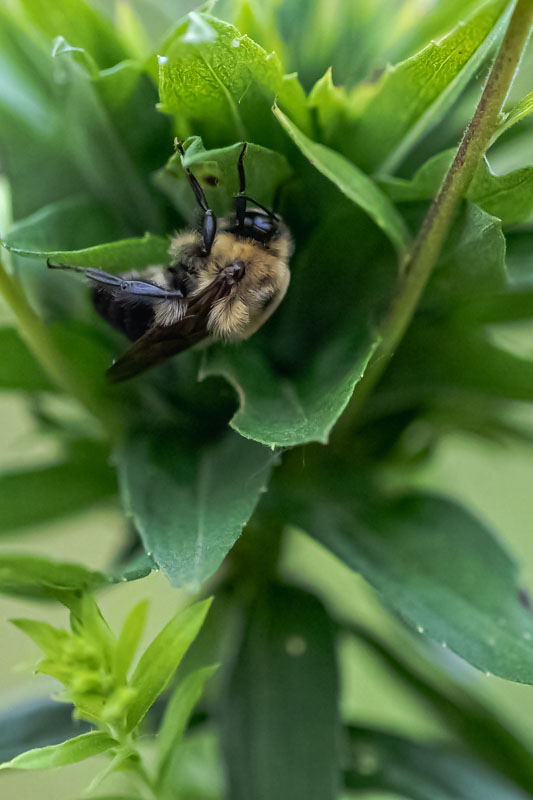
Brown-belted Bumblebee
(Bombus griseocollis)
| D79A0278 | 2235X3353 |
| Image Details | Field Reference Details |
| Camera | Canon EOS 5D Mk IV |
| Lens | EF100mm f/2.8L Macro IS USM |
| ISO | 16000 |
| Aperture | f/2.8 |
| Shutter | 1/1250 |
| Wings | Transparent with fine venation; may show a subtle smoky or amber tint near the base when backlit. |
| Body | Robust and very hairy; thorax pale yellow to golden, abdomen with a distinct brown/black “belt” banding (gives the common name). |
| Eyes | Large, dark (brown to black), set laterally on the head. |
| Range | Widespread across much of North America — common in the northern and central United States and southern Canada. |
| Habitat | Open fields, meadows, gardens, roadsides and edges of woodlands; frequently visits flower-rich areas and pollinator plantings. |
| Perching | Males often rest on flowers, leaves, or stems; may hang upside-down on foliage for short periods while surveying territory. |
| Flight Style | Steady, low-to-medium flight with a characteristic “bumbling” appearance; capable of quick, agile maneuvers when visiting flowers. |
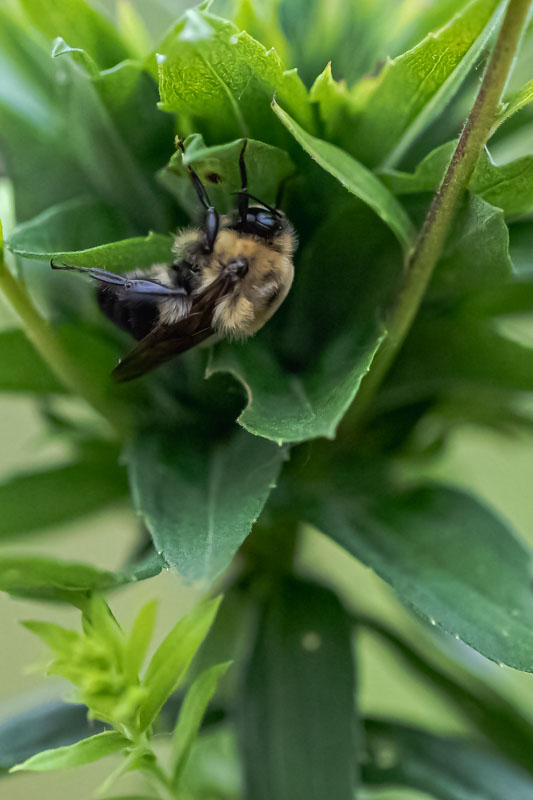
Brown-belted Bumblebee
(Bombus griseocollis)
| D79A0281 | 2235X3353 |
| Image Details | Field Reference Details |
| Camera | Canon EOS 5D Mk IV |
| Lens | EF100mm f/2.8L Macro IS USM |
| ISO | 16000 |
| Aperture | f/2.8 |
| Shutter | 1/1250 |
| Wings | Transparent with fine venation; may show a subtle smoky or amber tint near the base when backlit. |
| Body | Robust and very hairy; thorax pale yellow to golden, abdomen with a distinct brown/black “belt” banding (gives the common name). |
| Eyes | Large, dark (brown to black), set laterally on the head. |
| Range | Widespread across much of North America — common in the northern and central United States and southern Canada. |
| Habitat | Open fields, meadows, gardens, roadsides and edges of woodlands; frequently visits flower-rich areas and pollinator plantings. |
| Perching | Males often rest on flowers, leaves, or stems; may hang upside-down on foliage for short periods while surveying territory. |
| Flight Style | Steady, low-to-medium flight with a characteristic “bumbling” appearance; capable of quick, agile maneuvers when visiting flowers. |
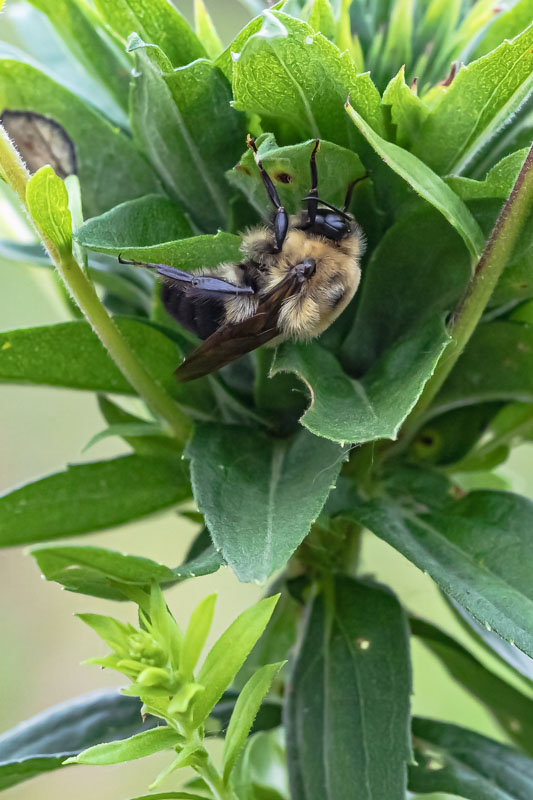
Brown-belted Bumblebee
(Bombus griseocollis)
| D79A0292 | 2235X3353 |
| Image Details | Field Reference Details |
| Camera | Canon EOS 5D Mk IV |
| Lens | EF100mm f/2.8L Macro IS USM |
| ISO | 8000 |
| Aperture | f/10.0 |
| Shutter | 1/50 |
| Wings | Transparent with fine venation; may show a subtle smoky or amber tint near the base when backlit. |
| Body | Robust and very hairy; thorax pale yellow to golden, abdomen with a distinct brown/black “belt” banding (gives the common name). |
| Eyes | Large, dark (brown to black), set laterally on the head. |
| Range | Widespread across much of North America — common in the northern and central United States and southern Canada. |
| Habitat | Open fields, meadows, gardens, roadsides and edges of woodlands; frequently visits flower-rich areas and pollinator plantings. |
| Perching | Males often rest on flowers, leaves, or stems; may hang upside-down on foliage for short periods while surveying territory. |
| Flight Style | Steady, low-to-medium flight with a characteristic “bumbling” appearance; capable of quick, agile maneuvers when visiting flowers. |
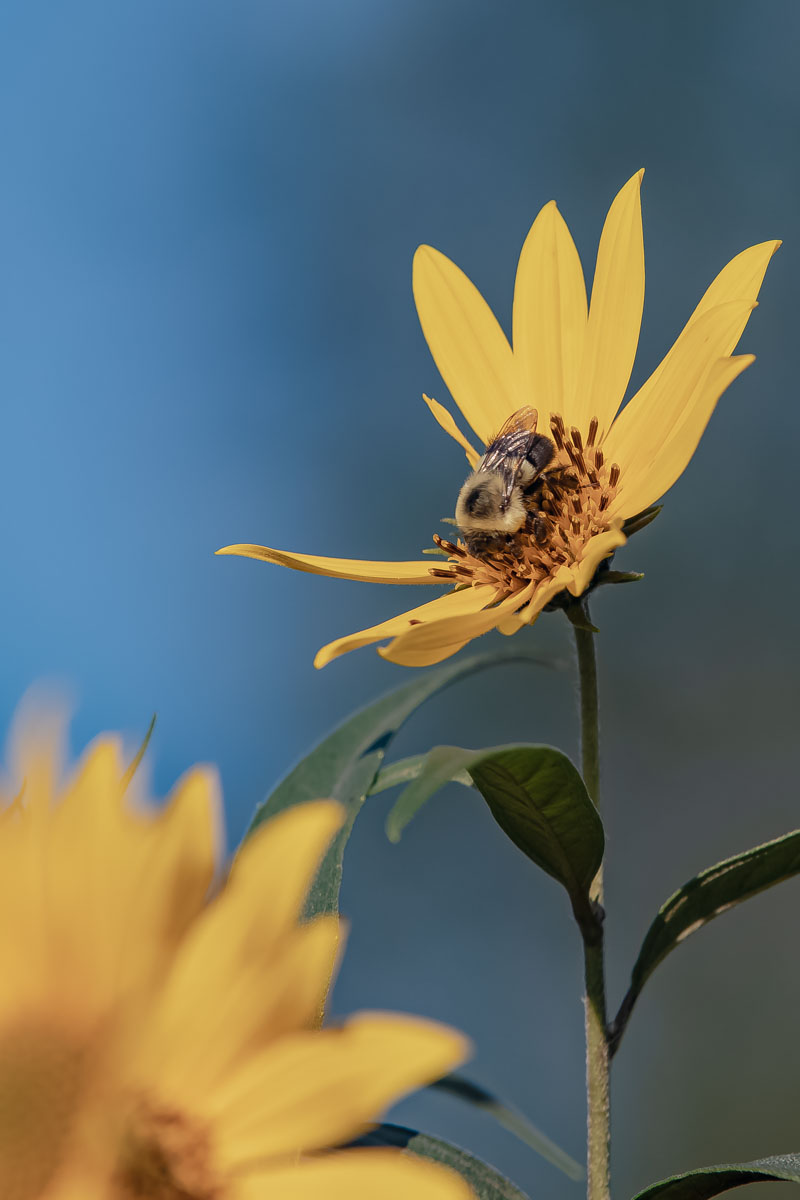
Brown-belted Bumblebee
(Bombus griseocollis)
| D79A4910 | 2508x3762 |
| Image Details | Field Reference Details |
| Camera | Canon EOS 5D Mk IV |
| Lens | EF100mm f/2.8L Macro IS USM |
| ISO | 8000 |
| Aperture | f/10.0 |
| Shutter | 1/50 |
| Wings | Transparent with fine venation; may show a subtle smoky or amber tint near the base when backlit. |
| Body | Robust and very hairy; thorax pale yellow to golden, abdomen with a distinct brown/black “belt” banding (gives the common name). |
| Eyes | Large, dark (brown to black), set laterally on the head. |
| Range | Widespread across much of North America — common in the northern and central United States and southern Canada. |
| Habitat | Open fields, meadows, gardens, roadsides and edges of woodlands; frequently visits flower-rich areas and pollinator plantings. |
| Perching | Males often rest on flowers, leaves, or stems; may hang upside-down on foliage for short periods while surveying territory. |
| Flight Style | Steady, low-to-medium flight with a characteristic “bumbling” appearance; capable of quick, agile maneuvers when visiting flowers. |
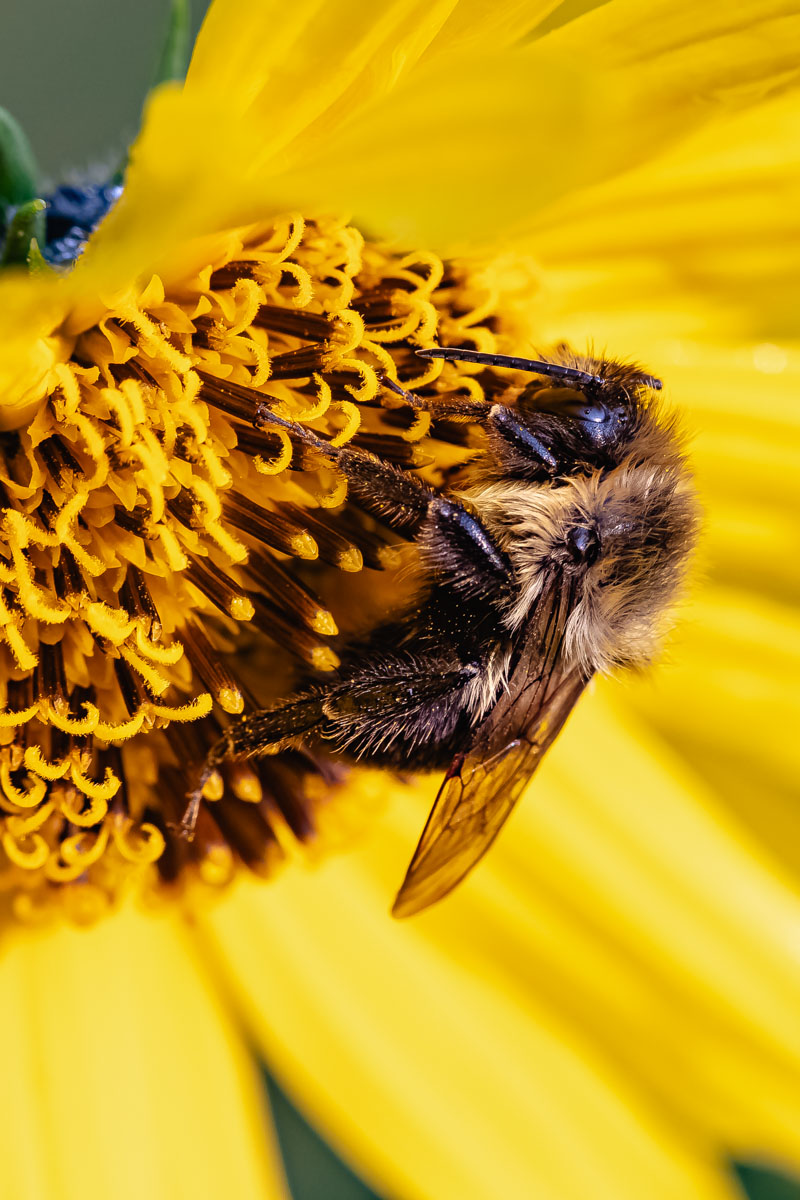
Brown-belted Bumblebee
(Bombus griseocollis)
| D79A5241 | 2757x4135 |
| Image Details | Field Reference Details |
| Camera | Canon EOS 5D Mk IV |
| Lens | EF100mm f/2.8L Macro IS USM |
| ISO | 8000 |
| Aperture | f/10.0 |
| Shutter | 1/50 |
| Wings | Transparent with fine venation; may show a subtle smoky or amber tint near the base when backlit. |
| Body | Robust and very hairy; thorax pale yellow to golden, abdomen with a distinct brown/black “belt” banding (gives the common name). |
| Eyes | Large, dark (brown to black), set laterally on the head. |
| Range | Widespread across much of North America — common in the northern and central United States and southern Canada. |
| Habitat | Open fields, meadows, gardens, roadsides and edges of woodlands; frequently visits flower-rich areas and pollinator plantings. |
| Perching | Males often rest on flowers, leaves, or stems; may hang upside-down on foliage for short periods while surveying territory. |
| Flight Style | Steady, low-to-medium flight with a characteristic “bumbling” appearance; capable of quick, agile maneuvers when visiting flowers. |
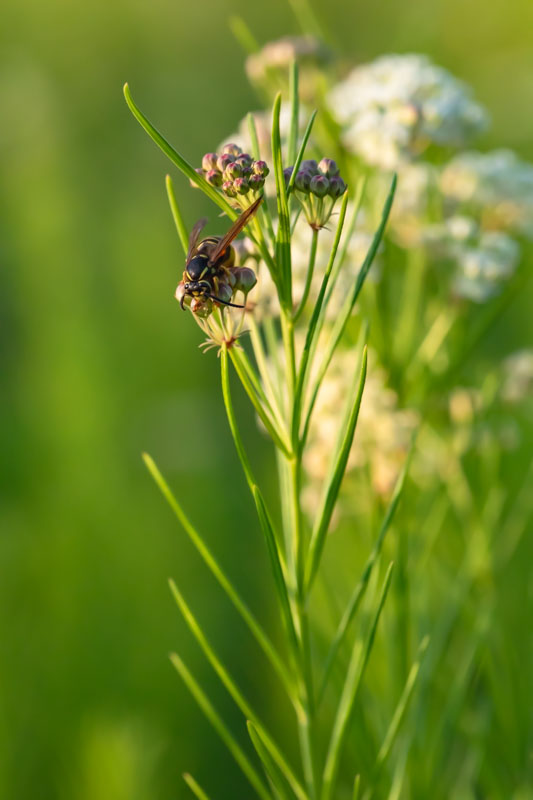
Bald-faced Hornet
(Dolichovespula maculata)
| D79A0410 | 4480x6720 |
| Image Details | Field Reference Details |
| Camera | Canon EOS 5D Mk IV |
| Lens | EF100mm f/2.8L Macro IS USM |
| ISO | 2500 |
| Aperture | f/7.1 |
| Shutter | 1/3200 |
| Size | Workers ~12–14 mm; queens up to ~18–20 mm |
| Key ID Marks | Glossy black wasp with crisp white patterning; mostly white face (“bald”); white bands on rear abdomen; three pale stripes on thorax; dark wings. |
| Face | White mask with black center line; stout, dark mandibles. |
| Thorax | Black with pale/white shoulder stripes; robust; wings smoky to dark. |
| Abdomen | Black with white bands/patches; tip usually white. |
| Antennae | Dark (not orange); moderately long and slightly curved. |
| Legs | Dark with pale joints; dangling in flight less than in paper wasps. |
| Nest | Large gray paper nest, football-shaped, usually aerial (trees, eaves). Strongly defensive near nest. |
| Behavior / Diet | Predatory on flies, caterpillars, other insects; also takes nectar and fruit juices. |
| Season | Late spring through fall; colonies annual—workers and males die with frost, new queens overwinter. |
| Habitat | Yards, wood edges, parks, gardens; often near trees/shrubs. |
| Range | Widespread across most of U.S. and southern Canada. |
| Similar Species | Paper wasps (Polistes) are slimmer with orange antennae and long legs; yellowjackets (Vespula) are smaller with yellow (not white) markings. |
| Notes | Despite the name, it’s a large “yellowjacket” species rather than a true hornet. |
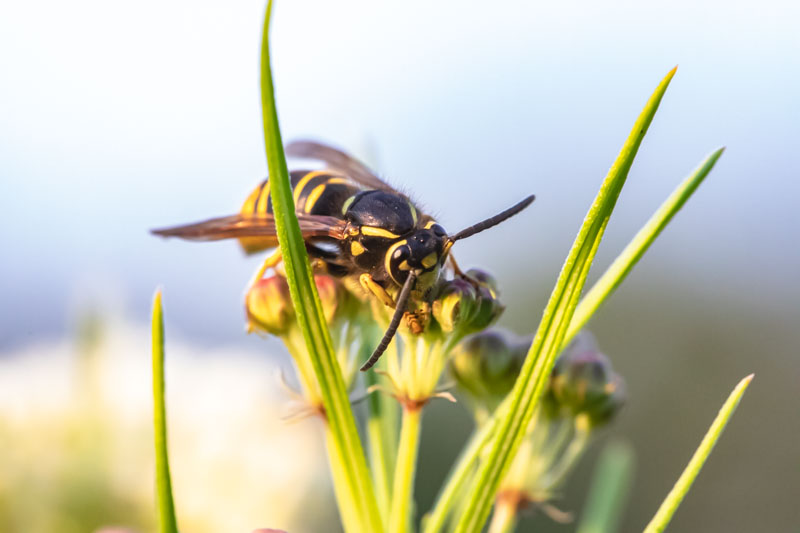
Bald-faced Hornet
(Dolichovespula maculata)
| D79A0363 | 2757x4135 |
| Image Details | Field Reference Details |
| Camera | Canon EOS 5D Mk IV |
| Lens | EF100mm f/2.8L Macro IS USM |
| ISO | 2500 |
| Aperture | f/7.1 |
| Shutter | 1/3200 |
| Size | Workers ~12–14 mm; queens up to ~18–20 mm |
| Key ID Marks | Glossy black wasp with crisp white patterning; mostly white face (“bald”); white bands on rear abdomen; three pale stripes on thorax; dark wings. |
| Face | White mask with black center line; stout, dark mandibles. |
| Thorax | Black with pale/white shoulder stripes; robust; wings smoky to dark. |
| Abdomen | Black with white bands/patches; tip usually white. |
| Antennae | Dark (not orange); moderately long and slightly curved. |
| Legs | Dark with pale joints; dangling in flight less than in paper wasps. |
| Nest | Large gray paper nest, football-shaped, usually aerial (trees, eaves). Strongly defensive near nest. |
| Behavior / Diet | Predatory on flies, caterpillars, other insects; also takes nectar and fruit juices. |
| Season | Late spring through fall; colonies annual—workers and males die with frost, new queens overwinter. |
| Habitat | Yards, wood edges, parks, gardens; often near trees/shrubs. |
| Range | Widespread across most of U.S. and southern Canada. |
| Similar Species | Paper wasps (Polistes) are slimmer with orange antennae and long legs; yellowjackets (Vespula) are smaller with yellow (not white) markings. |
| Notes | Despite the name, it’s a large “yellowjacket” species rather than a true hornet. |
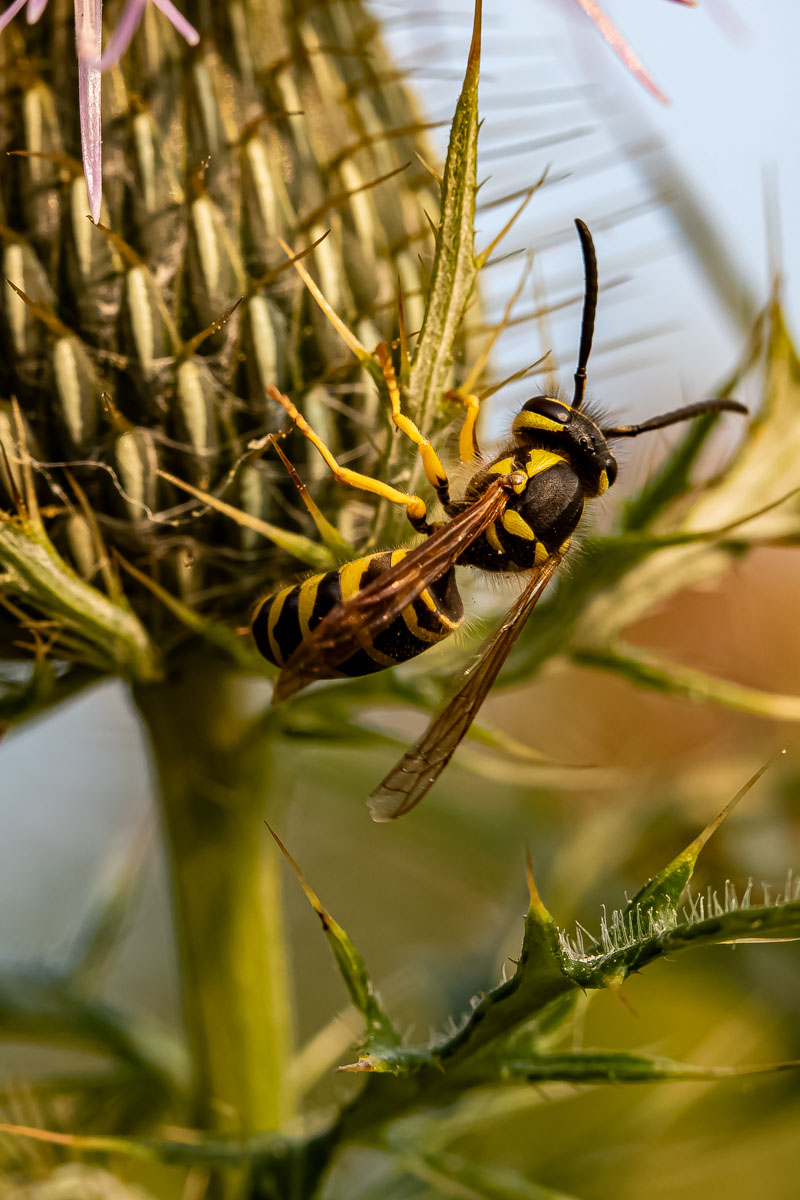
Yellowjacket
Photo ID: D79A5300
2600x3900
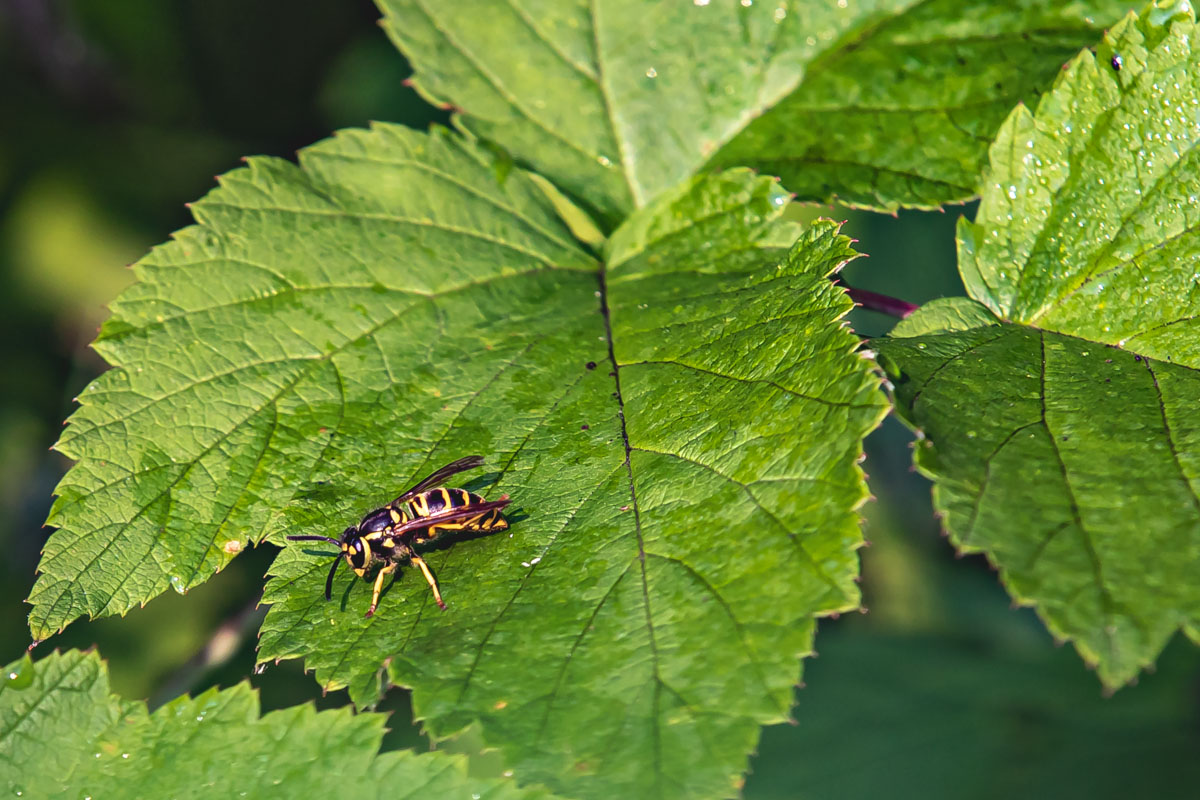
Yellowjacket
(Spilomyia longicornis)
| _21A1756 | 2555x1703 |
| Image Details | Field Reference Details |
| Camera | Canon EOS 5D Mk IV |
| Lens | EF70-200mm f/2.8L IS II USM (2x) |
| ISO | 200 |
| Aperture | f/8.0 |
| Shutter | 1/250 |
| Wings | Narrow and opaque with brown veining. |
| Body | Yellow and glossy black head, thorax, and abdomen with fine hair. The "waist" is thin between the thorax and abdomen. |
| Eyes | Black |
| Range | Eastern and Central U.S. |
| Habitat | Ponds, marshes, slow-moving streams, grassy fields near water. |
| Perching | Likes swaying tall grasses or twigs; often perches in open sunlight. |
| Flight Style | Fluttery, slow |
GET IN TOUCH
Fraley Design, L.L.C.16380 Java Ln
Lakeville, MN, 55044, US
P: (952) 855-2600